.
Contents
- Bloody Beaches: The Marines at Peleliu
- Sidebar: The Divisions and their Commanders
- Sidebar: The Changing Nature of Japanese Tactics
- Sidebar: Naval Gunfire Support for Peleliu
- The Japanese Defenses
- The Assault in the Center
- Sidebar: A Horrible Place
- Sidebar: Special Reef-crossing Techniques
- The Assault Continues
- Sidebar: A Paucity of Reserves
- The Early Battle in the Division Center
- The 7th Marines’ Complete Destruction of Enemy in the South
- Maneuver and Opportunity
- Encirclement of the Umurbrogol Pocket
- Encirclement of Umurbrogol and Seizure of Northern Peleliu
- The Umurbrogol Pocket: Peleliu’s Character Distilled
- Post-assault Operations in the Palaus
- Was the Seizure of Peleliu Necessary? Costs vs. Benefits
- Sidebar: Tom Lea’s Paintings
- Sidebar: For Extraordinary Heroism
- Sources
- About the Author
- About the Series
- Transcriber’s Notes
Bloody Beaches:
The Marines
at Peleliu
Marines in
World War II
Commemorative Series
By Brigadier General
Gordon D. Gayle
U.S. Marine Corps (Ret)


TABLE OF DISTANCES FROM PELELIU
In Nautical Miles
| Pearl Harbor | 3990 |
| Guadalcanal | 1589 |
| Espiritu Santo | 2067 |
| Admiralty Islands | 960 |
| Hollandia | 705 |
| Morotai | 430 |
| Saipan | 820 |
| Yap | 237 |
| Ulithi | 323 |
| Truk | 1030 |
| Davao | 540 |
| Manila | 920 |
| Tokyo | 1725 |
Bloody Beaches:
The Marines at Peleliu
by Brigadier General Gordon D. Gayle, USMC (Ret)
On D-Day 15 September 1944, five infantry battalions of the 1st Marine Division’s 1st, 5th, and 7th Marines, in amphibian tractors (LVTs) lumbered across 600–800 yards of coral reef fringing smoking, reportedly smashed Peleliu in the Palau Island group and toward five selected landing beaches. That westward anchor of the 1,000-mile-long Caroline archipelago was viewed by some U.S. planners as obstacles, or threats, to continued advances against Japan’s Pacific empire.
The Marines in the LVTs had been told that their commanding general, Major General William H. Rupertus, believed that the operation would be tough, but quick, in large part because of the devastating quantity and quality of naval gunfire and dive bombing scheduled to precede their assault landing. On some minds were the grim images of their sister 2d Marine Division’s bloody assault across the reefs at Tarawa, many months earlier. But 1st Division Marines, peering over the gunwales of their landing craft saw an awesome scene of blasting and churning earth along the shore. Smoke, dust, and the geysers caused by exploding bombs and large-caliber naval shells gave optimists some hope that the defenders would become casualties from such preparatory fires; at worst, they would be too stunned to respond quickly and effectively to the hundreds of on-rushing Marines about to land in their midst.
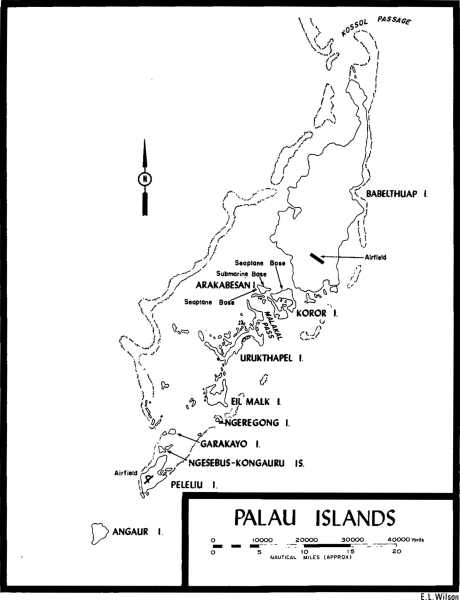
PALAU ISLANDS
2 Just ahead of the first wave of troops carrying LVTs was a wave of armored amphibian tractors (LVTAs) mounting 75mm howitzers. They were tasked to take under fire any surviving strongpoints or weapons which appeared at the beach as the following troops landed. And just ahead of the armored tractors, as the naval gunfire lifted toward deeper targets, flew a line of U.S. Navy fighter aircraft, strafing north and south along the length of the beach defenses, parallel to the assault waves, trying to keep all beach defenders subdued and intimidated as the Marines closed the defenses.3 Meanwhile, to blind enemy observation and limit Japanese fire upon the landing waves, naval gunfire was shifted to the hill massif northeast of the landing beaches.

Captions by the artist, Tom Lea
“Going In—First Wave For an hour we plowed toward the beach, the sun above us coming down through the overcast like a silver burning ball.... Over the gunwale of a craft abreast of us I saw a Marine, his face painted for the jungle, his eyes set for the beach, his mouth set for murder, his big hands quiet now in the last moments before the tough tendons drew up to kill.”
That “massif,” later to be called the Umurbrogol Pocket, was the first of two deadly imponderables, as yet unknown to the division commander and his planners. Although General Rupertus had been on temporary duty in Washington during most of his division’s planning for the Peleliu landing, he had been well briefed for the operation.
The first imponderable involved the real character of Umurbrogol, which aerial photos indicated as a rather gently rounded north-south hill, commanding the landing beaches some 2,000–4,000 yards distant. Viewed in these early photos, the elevated terrain appeared clothed in jungle scrub, which was almost entirely removed by the preparatory bombardment and then subsequent heavy artillery fire directed at it. Instead of a gently rounded hill, the Umurbrogol area was in fact a complex system of sharply uplifted coral ridges, knobs, valleys, and sinkholes. It rose above the level remainder of the island from 50 to 300 feet, and provided excellent emplacements for cave and tunnel defenses. The Japanese had made the most of what this terrain provided during their extensive period of occupation and defensive preparations.
The second imponderable facing the Marines was the plan developed by Colonel Kunio Nakagawa, the officer who was to command the force on Peleliu, and his superior, Lieutenant General Sadae Inoue, back on Koror. Their concept of defense had changed considerably from that which was experienced by General Rupertus at Guadalcanal and Cape Gloucester, and, in fact, negated his concept of a tough, but quick campaign.
As seen from the air on D-Day, 15 September 1944, Beaches White 1 and 2, on which the 1st and 3d Battalions, 1st Marines, landed. Capt George P. Hunt’s Company K, 3/1, was on the extreme left flank of the 1st Marine Division.
Department of Defense Photo (USN) 283745
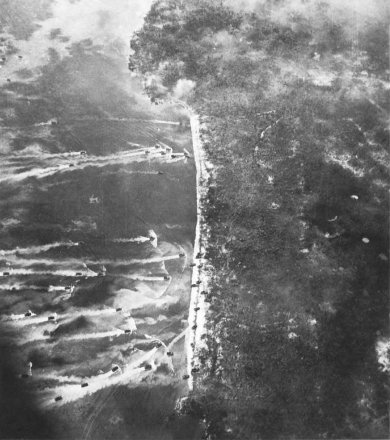
Instead of relying upon a presumed moral superiority to defeat the4 attackers at the beach, and then to use bushido spirit and banzai tactics to throw any survivors back into the sea, Peleliu’s defenders would delay the attacking Marines as long as they could, attempting to bleed them as heavily as possible. Rather than depending upon spiritual superiority, they would combine the devilish terrain with the stubborn, disciplined, Japanese soldiers to relinquish Peleliu at the highest cost to the invaders. This unpleasant surprise for the Marines marked a new and important adjustment to the Japanese tactics which were employed earlier in the war.
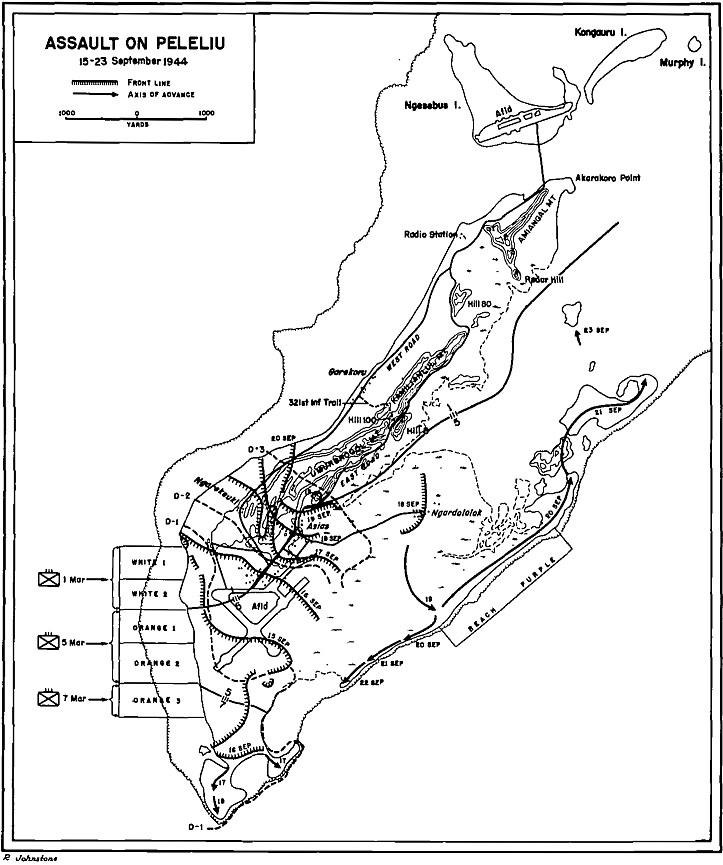
ASSAULT ON PELELIU
15–23 September 1944
R Johnstone
Little or nothing during the trip into the beaches and the touchdown revealed the character of the revised Japanese tactical plan to the five Marine assault battalions. Bouncing across almost half a mile of coral fronting the landing beaches (White 1 and 2, Orange 1, 2, and 3), the tractors passed several hundred “mines,” intended to destroy any craft which approached or ran over them. These “mines” were aerial bombs, set to be detonated by wire control from observation points onshore. However, the preliminary bombardment had so disrupted the wire controls, and so blinded the observers, that the defensive mining did little to slow or destroy the assaulting tractors.
As the tractors neared the beaches, they came under indirect fire from mortars and artillery. Indirect fire against moving targets generates more apprehension than damage, and only a few vehicles were lost to that phase of Japanese defense. Such fire did, however, demonstrate that the preliminary bombardment had not disposed of all the enemy’s heavy fire capability. More disturbingly, as the leading waves neared the beaches, the LVTs were hit by heavy enfilading artillery and antiboat gun fire coming from concealed bunkers on north and south flanking points.
The defenses on the left (north) flank of Beach White 1, assaulted by the 3d Battalion, 1st Marines (Lieutenant Colonel Stephen V. Sabol), were especially deadly and effective. They disrupted the critical regimental and division left flank. Especially costly to the larger landing plan, these guns shortly thereafter knocked out tractors carrying important elements of the battalion’s and the regiment’s command and control personnel and equipment. The battalion and then the regimental commander both found themselves ashore in a brutally vicious beach fight, without the means of communication necessary to comprehend their situations fully, or to take the needed remedial measures.
The critical mission to seize the “The Point” dominating the division left flank had gone to one of the 1st Regiment’s most experienced company commanders: Captain George P. Hunt, a veteran of Guadalcanal and New Britain, (who, after the war, became a long-serving managing editor of Life magazine). Hunt had developed plans involving specific assignments for each element of his company. These had been rehearsed until every individual knew his role and how it fit into the company plan. Each understood his mission’s criticality.
D-Day and H-Hour brought heavier than expected casualties. One of the company’s platoons was pinned down all day in the fighting at the beach. The survivors of the rest of the company wheeled left, as planned, onto the flanking point. Moving grimly ahead, they pressed assaults upon the many defensive emplacements. Embrasures in the pillboxes and casements were blanketed with small-fire arms and smoke, then attacked with demolitions5 and rifle grenades. A climax came at the principal casement, from which the largest and most effective artillery fire had been hitting LVTs on the flanks of following landing waves. A rifle grenade hit the gun muzzle itself, and ricocheted into the casement, setting off explosions and flames. Japanese defenders ran out the rear of the blockhouse, their clothing on fire and ammunition exploding in their belts. That flight had been anticipated, and some of Hunt’s Marines were in position to cut them down.
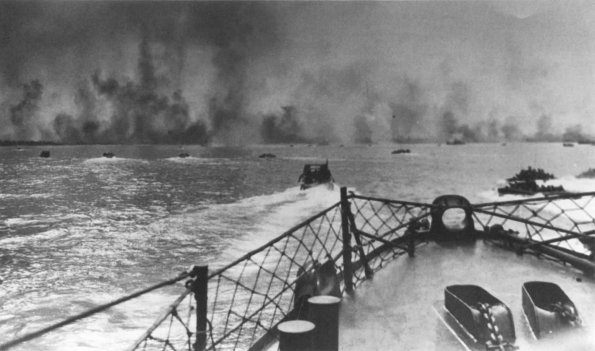
Department of Defense Photo (USMC) 94913
The skies over the landing beaches of Peleliu are blackened with smoke rising from the ground as the result of the combined naval and aerial prelanding bombardment, as amphibian tractors rush shoreward carrying the assault waves.
At dusk, Hunt’s Company K held the Point, but by then the Marines had been reduced to platoon strength, with no adjacent units in contact. Only the sketchy radio communications got through to bring in supporting fires and desperately needed re-supply. One LVT got into the beach just before dark, with grenades, mortar shells, and water. It evacuated casualties as it departed. The ammunition made the difference in that night’s furious struggle against Japanese determined to recapture the Point.
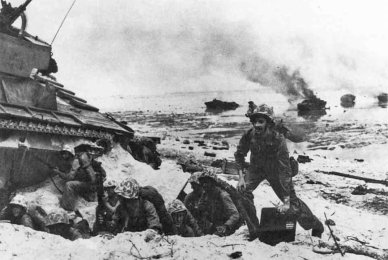
The next afternoon, Lieutenant Colonel Raymond G. Davis’ 1/1 moved its Company B to establish contact with Hunt, to help hang onto the bitterly contested positions. Hunt’s company also regained the survivors of the platoon which had been pinned at the beach fight throughout D-Day. Of equal importance, the company regained artillery and naval gunfire communications, which proved critical during the second night. That night, the Japanese organized another and heavier—two companies—counterattack directed at the Marines at the Point. It was narrowly defeated. By mid-morning, D plus 2, Hunt’s survivors, together with Company B, 1/1, owned the Point, and could look out upon some 500 Japanese who had died defending or trying to re-take it.
To the right of Puller’s struggling 3d Battalion, his 2d Battalion, Lieutenant Colonel Russell E. Honsowetz commanding, met artillery and mortar opposition in landing, as well as machine-gun fire from still effective beach defenders. The same was true for 5th Marines’ two assault battalions, Lieutenant Colonel Robert W. Boyd’s 1/5 and Lieutenant Colonel Austin C. Shofner’s 3/5, which fought through the beach defenses and toward the edge of the clearing looking east over the airfield area.
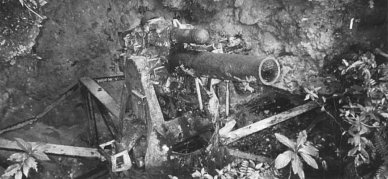
Caption and photograph by Phillip D. Orr
Situated in a cave overlooking the airfield is this heavy caliber Japanese antiboat gun. It had a field of fire which included the invasion beaches and the airfield.
Damaged heavily in the D-Day bombardment, this Japanese pillbox survives on the southern promontory of White Beach. Now vacant, its gun lies on the beach.
Caption and photograph by Phillip D. Orr
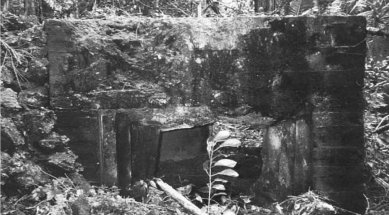
On the division’s right flank, Orange 3, Major Edward H. Hurst’s 3/7 had to cross directly in front of a commanding defensive fortification flanking the beach as had Marines in the flanking position on the Point. Fortunately, it was not as close as the Point position, and did not inflict such heavy damage. Nevertheless, its enfilading fire, together with some natural obstructions on the beach caused Company K, 3/7, to land left of its planned landing beach, onto the right half of beach Orange 2, 3/5’s beach. In addition to being out of position, and out of contact with the company to its right, Company K, 3/7, became intermingled with7 Company K, 3/5, a condition fraught with confusion and delay. Major Hurst necessarily spent time regrouping his separated battalion, using as a coordinating line a large antitank ditch astride his line of advance. His eastward advance then resumed, somewhat delayed by his efforts to regroup.
Any delay was anathema to the division commander, who visualized momentum as key to his success. The division scheme of maneuver on the right called for the 7th Marines (Colonel Herman H. Hanneken) to land two battalions in column, both over Beach Orange 3. As Hurst’s leading battalion advanced, it was to be followed in trace by Lieutenant Colonel John J. Gormley’s 1/7. Gormley’s unit was to tie into Hurst’s right flank, and re-orient southeast and south as that area was uncovered. He was then to attack southeast and south, with his left on Hurst’s right, and his own right on the beach. After Hurst’s battalion reached the opposite shore, both were to attack south, defending Scarlet 1 and Scarlet 2, the southern landing beaches.
At the end of a bloody first hour, all five battalions were ashore. The closer each battalion was to Umurbrogol, the more tenuous was its hold on the shallow beachhead. During the next two hours, three of the division’s four remaining battalions would join the assault and press for the momentum General Rupertus deemed essential.
Following close behind Sabol’s 3/1, the 1st Marines’ Colonel Puller landed his forward command group. As always, he was eager to be close to the battle, even if that location deprived him of some capacity to develop full supporting fires. With limited communications, and now with inadequate numbers of LVTs for follow-on waves, he struggled to ascertain and improve his regiment’s situation. His left unit (Company K, 3/1) had two of its platoons desperately struggling to gain dominance at the Point. Puller’s plan to land Major Davis’ 1st Battalion behind Sabol’s 3/1, to reinforce the fight for the left flank, was thwarted by the H-hour losses in LVTs. Davis’ companies had8 to be landed singly and his battalion committed piecemeal to the action. On the regiment’s right, Honsowetz’ 2/1 was hotly engaged, but making progress toward capture of the west edges of the scrub which looked out onto the airfield area. He was tied on his right into Boyd’s 1/5, which was similarly engaged.
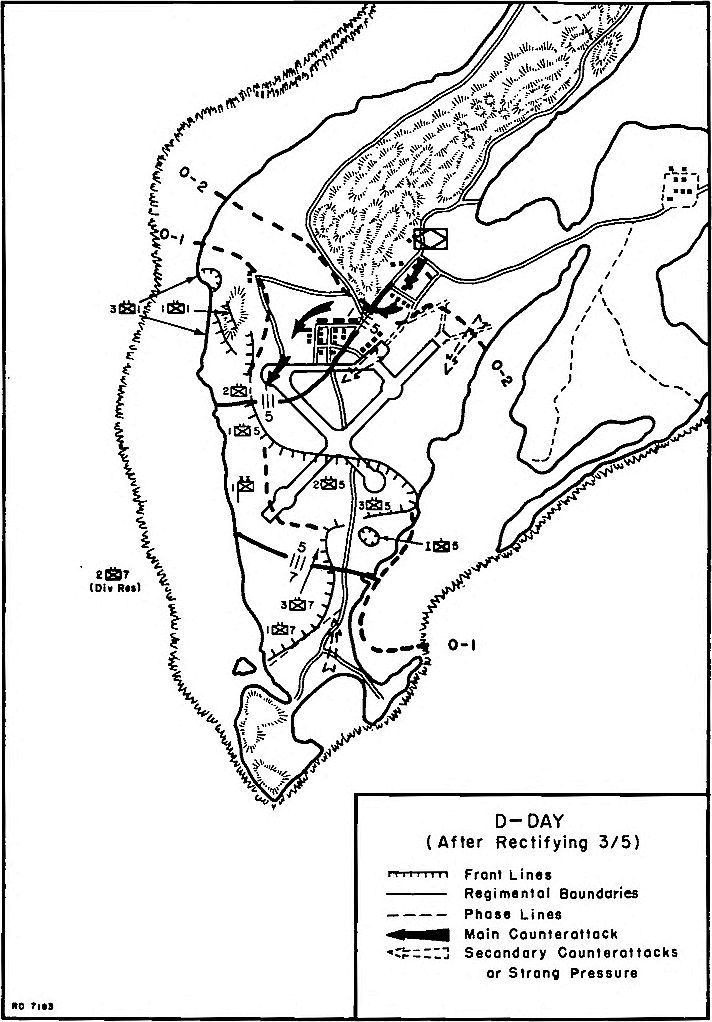
D-DAY
(After Rectifying 3/5)
In the beachhead’s southern sector, the landing of Gormley’s 1/7 was delayed somewhat by its earlier losses in LVTs. That telling effect of early opposition would be felt throughout the remainder of the day. Most of Gormley’s battalion landed on the correct (Orange 3) beach, but a few of his troops were driven leftward by the still enfilading fire from the south flank of the beach, and landed on Orange 2, in the 5th Marines’ zone of action. Gormley’s battalion was brought fully together behind 3/7 however, and as Hurst’s leading 3/7 was able to advance east, Gormley’s 1/7 attacked southeast and south, against prepared positions.
Hanneken’s battle against heavy opposition from both east and south developed approximately as planned. Suddenly, in mid-afternoon, the opposition grew much heavier. Hurst’s 3/7 ran into a blockhouse, long on the Marines’ map, which had been reported destroyed by pre-landing naval gunfire. As a similar situation later met on Puller’s inland advance, the blockhouse showed little evidence of ever having been visited by heavy fire. Preparations to attack and reduce this blockhouse further delayed the 7th Marines’ advance, and the commanding general fretted further about loss of momentum.
[Sidebar (page 2):]
The Divisions and their Commanders
The Peleliu operation was to be conducted by two divisions, one Marine and one Army. In the Pacific area since mid-1942, the 1st Marine Division was a veteran, combat-tested organization which launched the first offensive landing in the Pacific War when it attacked Guadalcanal on 7 August 1942. After a period in Australia of rest, recuperation, and training of newly joined Marines, the division made its second amphibious assault on 26 December 1943 at Cape Gloucester on New Britain Island. When the division landed on Peleliu, its regiments (1st, 5th, and 7th Marines, all infantry, and 11th Marines, artillery) contained officers and enlisted Marine veterans of both landings as well as new troops. Before World War II ended, the 1st Division was to participate in one last battle, the landing on Okinawa.

Major General William H. Rupertus, the 1st Division commander, had been with the division since early 1942. As a brigadier general, he was the assistant division commander to Major General Alexander A. Vandegrift during the Guadalcanal campaign. He took command of the division for the Cape Gloucester operation. General Rupertus was commissioned in 1913 and served as commander of a Marine ship’s detachment in World War I. During subsequent years, he was assigned duty in Haiti and China. Following the Peleliu campaign, he was named Commandant of the Marine Corps Schools in Quantico. General Rupertus died of a heart attack on 25 March 1945, while still on active duty.
The Army’s 81st Infantry Division—the Wildcats—was formed in August 1917 at Camp Jackson, South Carolina. It saw action in France at the Meuse-Argonne in World War I, and was deactivated following the end of the war. The division was reactivated in June 1942. It went to several Pacific training bases before its first combat assignment, the landing on Angaur. After securing Angaur, it relieved units of the 1st Marine Division on Peleliu. When Peleliu was secured, the Wildcats began training for Operation Olympic—the assault on Japan proper. The Japanese surrendered unconditionally after suffering two atomic bomb attacks. As a result, instead of invading Japan, the 81st occupied it. On 10 January, the 81st Infantry Division was once more deactivated.
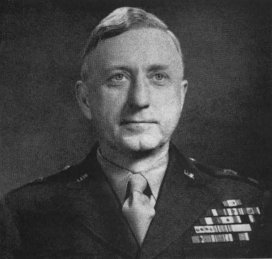
Major General Paul J. Mueller, USA, the commander of the 81st Division, was a graduate of the famous West Point Class of 1915. He commanded an infantry battalion in France in World War I, and during the interwar period he had a succession of assignments to infantry commands, staff billets, and schools. In August 1941 he assumed command of the 81st Infantry Division at Fort Rucker, Alabama, and moved his division during its training period successively from Florida to Tennessee to California before its commitment to the battle for Angaur and Peleliu. General Mueller served on active duty until 1954, when he retired. He died in 1964.
[Sidebar (page 5):]
The Changing Nature of Japanese Tactics
Japan launched its December 1941 surprise attacks in the expectation that its forces could quickly seize a forward line of Pacific and Asian empire. Thereafter, it expected to defend these territories stubbornly enough to tire and bleed the Allies and then to negotiate a recognition of Japanese hegemony.
This strategic concept was synchronized with the fanatic Japanese spirit of bushido. Faith in their army’s moral superiority over lesser races led the Japanese to expect 19th-century banzai tactics to lead invariably to success. Expectations and experience meshed until their 1942 encounters with the Allies, particularly with Americans in the Solomons. Thereafter, it took several campaigns to internalize the lessons of defeat by modern infantry weapons in the hands of the determined Allies.
To Americans, these Japanese misconceptions were alarming, but cost-effective: It was easier, and less costly, to mow down banzai attacks than to dig stubborn defenders out of fortified positions.
By spring of 1944, the lessons had permeated to the highest levels of Japan’s army command. When General Hideki Tojo instructed General Inoue to defend the Palaus deliberately and conservatively, he was bringing Japanese tactics into support of Japanese strategy. Henceforth, Japanese soldiers would dig in and hunker down, to make their final defenses as costly as possible to the attacking Americans.
[Sidebar (page 7):]
Naval Gunfire Support for Peleliu
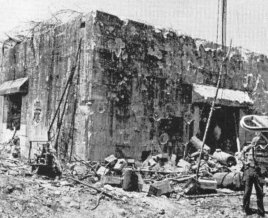
Department of Defense Photo (USMC) 95115
In their earlier operations, especially at Guadalcanal, the primary experience of 1st Division Marines with naval gunfire was at the receiving end. On New Britain, the character and disposition of Japanese defenses did not call for extensive pre-landing fire support, nor did subsequent operations ashore. The naval gunfire to which the Guadalcanal veterans were exposed frequently and heavily damaged planes and installations ashore. Its effect upon dug-in Marines was frightening and sobering, but rarely destructive.
During the planning for Peleliu, the division staff initially had no trained naval gunfire (NGF) planner. When one arrived, he was hampered by the cumbersome communications link back to higher headquarters, Lieutenant General Holland M. Smith’s Fleet Marine Force, Pacific (FMFPac), in Honolulu, which would provide the essential targeting information for the division’s NGF plan. FMFPac also would plan and allocate the available gunfire resources to the targets deemed important by the division staff’s planners. The preoccupation of FMFPac with the ongoing Marianas campaigns, as well as illness on the staff of Rear Admiral Jesse B. Oldendorf, Commander, Naval Gunfire Support Group, further limited and constrained the preparations. Heavy ammunition expenditures in the Marianas reduced ammunition availability for Peleliu.
Surprisingly, during the delivery of U.S. preparatory fires, there was no Japanese response. This prompted Oldendorf to report all known targets destroyed, and to cancel preparatory fires scheduled for D plus 3. An unintentional benefit of this uncoordinated change in naval gunfire plan may have resulted in there being more shells available for post-landing NGF support. But the costliest effect of inadequate NGF was that the flanking positions north and south of the landing beaches were not taken out. The selection of naval gunfire targets could certainly have been done with more careful attention. Colonel Lewis B. Puller, the 1st Marines commander, had specifically asked for the destruction of the positions dominating his landing on the division left flanks. Failure to do so was paid for in blood, courage, and time during the critical battle for the Point.
Subsequent to D-Day there were numerous instances of well-called and -delivered naval gunfire support: night illumination during the night of 15–16 September, the destruction of two major blockhouses earlier reported “destroyed,” and effective support of the Ngesebus landing toward the end of the battle.
The Japanese Defenses
On the enemy’s side, Lieutenant General Sadae Inoue, a fifth generation warrior of stout military reputation, commanding the 14th Infantry Division, fresh from the Kwangtung Army in China, met in Tokyo in March 1944 with Japanese Premier Hideki Tojo, who was also Minister of War. Tojo had concluded that Japan was no longer able to hold the Palaus against growing Allied naval dominance in the Western Pacific. Instead, he had decided to sell the Palaus to the United States at the highest possible cost to Americans in blood and time. He ordered Inoue to take his division to the Palaus, to take command of all Japanese forces there, and to defend the Palau Islands as long as possible, denying its use to the Americans—and killing as many as possible in the undertaking.
As his division sailed to the Palaus, Inoue flew ahead, reconnoitered his new locale by air for two days, and concluded that Peleliu (with satellite air strips on Angaur and Ngesebus) was the key to his defenses. Earlier U.S. attention to Peleliu during the Task Force 58 March strikes seemed to confirm that judgment. To defend Peleliu, Inoue immediately settled upon a commander, a mission, and a force level. Peleliu had for some time been under occupation and administrative command of a rear admiral, who had used his forces’ construction resources and capability to build blockhouses and many reinforced concrete structures above ground, while improving existing9 caves and tunnels under Peleliu’s rich concealment of overlying jungle, scrub, and vines.

Caption by the artist, Tom Lea
“The Beach ... My First View as I Came Around From the Ramp of our LVT We ground to a stop, after a thousand years, on the coarse coral.... And we ran down the ramp and came around the end of the LVT, splashing ankle-deep up the surf to the white beach. Suddenly I was completely alone. Each man drew into himself when he ran down that ramp, into that flame. Those Marines flattened in the sand on that beach were dark and huddled like wet rats in death as I threw my body down among them.”
In these underground installations, the admiral’s personnel had well survived the Task Force 58 March attacks. Above ground, planes and installations were demolished. As Task Force 58 departed, the Japanese emerged, repaired what they could, but continued to focus upon underground installations. Together with a few Korean labor troops, their numbers totaled about 7,000, most of them lacking training and leadership for infantry action.
Leadership arrived in the person of Colonel Nakagawa, with his 6,500-man 2d Infantry Regiment (Reinforced). They had long battle experience in China. They were armed with 24 75mm artillery pieces, some 13–15 light tanks, about 100 .50-cal. machine guns, 15 81mm heavy mortars, and about 30 dual-purpose antiaircraft guns. Already on the island were a large number of very heavy (141mm) mortars, naval antiaircraft guns, and rudimentary rocket launchers for sending up large, unguided naval shells. Most significant, the regiment had Colonel Nakagawa and his battle-disciplined officers and noncommissioned officers. Nakagawa had already been awarded nine medals for leadership against the Chinese and was viewed as a “comer” within his officer corps.
Immediately upon arrival, Nakagawa reconnoitered his prospective battle area from the ground and from the air. He identified the western beaches, the Marines’ White and Orange Beaches, as the most probable landing sites. He immediately ordered his troops to dig in and construct beach defenses. At this time, a bureaucratic conflict arose. Vice Admiral Seiichi Itou, who was the senior officer and the senior naval officer on Peleliu, resented being subordinate to an Army officer much junior to him.
From Koror, Lieutenant General Inoue dispatched Major General Kenjiro Murai to Peleliu, to assume island command and to maintain “liaison” with Colonel Nakagawa. Murai was young, highly regarded, and, as the personal representative of Lieutenant General Inoue, was considered senior to the admiral. He left Nakagawa’s operational mission firmly in Nakagawa’s hands, as Inoue intended. Throughout the campaign, Nakagawa exercised operational control, and was assisted and counseled, but not commanded, by General Murai.
Nakagawa had a sound appreciation of his mission, of the situation, and of American firepower. He turned his attention to the fullest use of his principal advantage, the terrain. He so deployed and installed his forces to inflict all possible damage and casualties during the anticipated landing, and then to defend in depth for as long as possible. On Peleliu, that offered a vertical as well as a horizontal dimension to the defense.
He surveyed and registered artillery and mortar weapons over the10 width and depth of the reef off both eastern and western beaches, with planned heavy concentrations along the fringe of the western reef. In this he anticipated the American need to transfer follow-on waves from landing craft to the reef-crossing amphibian vehicles. He registered weapons on, and immediately inland from, the water’s edge, to subject landing troops to a hail of fire. Off-shore he laid 500 wire-controlled “mines.”

Caption by the artist, Tom Lea
“The Price Lying there in terror looking longingly up the slope to better cover, I saw a wounded man near me, staggering in the direction of the LVTs. His face was half bloody pulp and the mangled shreds of what was left of an arm hung down like a stick, as he bent over in his stumbling, shock-crazy walk. The half of his face that was still human had the most terrifying look of abject patience I have ever seen. He fell behind me, in a red puddle on the white sand.”
Colonel Nakagawa directed construction of beach obstacles, using rails and logs, and ordered antitank ditches dug. He emplaced troops in machine gun and mortar pits along, and inland from, the beaches, augmented by all the available barbed wire. On the north and south flanks of the beach, he constructed concrete emplacements to shelter and conceal antitank and antiboat artillery sited to enfilade the expected waves of landing craft.
Inland, he incorporated the already-built blockhouse and adjacent reinforced buildings into mutually supporting defensive complexes, with interconnecting communication lines and trenches.
Although believing the western beaches to be the most probable route of attack, he did not leave the southern (Scarlet) and eastern (Purple) beaches undefended. He committed one battalion to organize defenses in each area. The Purple Beaches were thoroughly organized, with contingent orders to the defenders to move into central Peleliu if the battle developed from the west, as expected. But the battalion committed to the south, Scarlet Beach, had orders to defend those stronger, more permanent emplacements to the end. Nakagawa assigned about 500 infantry and artillery to defend Ngesebus and about 1,000 naval personnel to defend northern Peleliu. Not under his command were the 1,500 defenders of Angaur.
The major part of his force and effort was committed to the 500 caves, tunnels, and firing embrasures in the coral ridges of central Peleliu. The naval units’ extensive earlier tunneling into the limestone ridges rendered occupants largely immune to general bombardments. Only lucky hits into the mouths of caves, or point-blank direct fire could damage the hidden defenses and their troops. The tunnels were designed for, or adapted to, various purposes: barracks, command centers, hospitals, storage and ammunition magazines, cooking areas complete with fresh water springs and seepage basins, and of course firing embrasures with elaborate concealment and protective devices, including a few sliding steel doors. Colonel Nakagawa expected very heavy prelanding bombardments. He expected his troops to survive them, and then to carry out his mission of delaying and bleeding the Americans.
On Koror, Lieutenant General Inoue was busy with the bulk of his forces, preparing for expected attacks against Babelthuap. The Allied11 “Stalemate” plan had indeed called for invasion of Babelthuap. As the anticipated invasion drew near, Inoue issued a proclamation to his troops, clearly reflecting Tojo’s instructions to delay and bleed. He pointed out the necessities to anticipate and endure the naval bombardment and to use the terrain to inflict casualties on the attackers. Without actually ordering troops to die, he included the words, “we are ready to die honorably.” He went on to say that dying, and losing the territory to the enemy, might contribute to the opening of a new phase of the war.
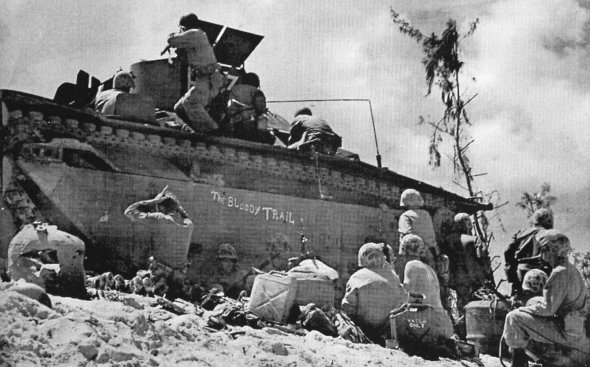
Department of Defense Photo (USMC) 95253
Engaged in the bitter struggle to establish the Peleliu beachhead, Marine riflemen get only momentary shelter behind an LVT, while other Marines atop the amphibian tractor fire at enemy targets. The name of the LVT was more than prophetic.
Embrasures in this well-sited, heavily reinforced position, possibly in the Pocket, indicate the location of Japanese weapons which devastated attacking Marines.
Department of Defense Photo (USMC) 107934
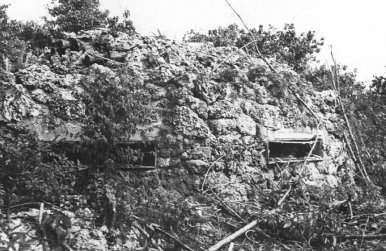
The Assault in the Center
As the 1st Marines battled to secure the left flank, and as the 7th Marines fought to isolate and then reduce the Japanese defenses in the southern end of Peleliu, the 5th Marines, Colonel Harold D. Harris commanding, was charged to drive across the airfield, cut the island in two, and then re-orient north and drive to secure the eastern half of the island. Shortly after the scheduled H plus one schedule, the 2d Battalion, 5th Marines, Major Gordon D. Gayle commanding, landed over Beach Orange 2, in trace behind 3/5. It moved directly east, through the dunes and scrub jungle, into and out of the antitank barrier, and to the west edge of the clearing surrounding the airfield. Passing through the lines of 3/5, Gayle’s battalion attacked12 west against scattered resistance from dug-outs and bomb shelters near the southern end of the airfield, and through the scrub area slightly farther south. The 3d Battalion’s mission was to clear that scrub, maintaining contact with 3/7 on its right, while 2/5 was to drive across the open area to reach the far side of the island. Advancing in its center and right, 2/5 battled completely across the island by mid-afternoon, echeloned its left rearward to keep contact with 1/5, and moved to re-orient its attack northward. The 2d Battalion’s right flank tied for a while into 3/5 in the woods to the south of the airfield, but then lost contact.
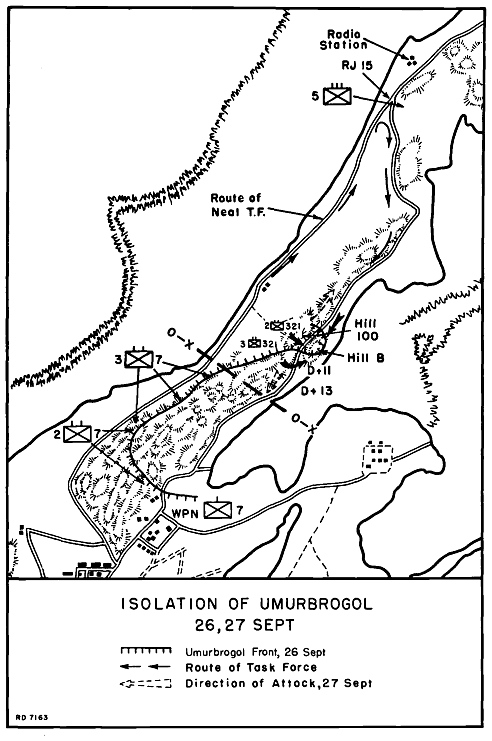
By this time, the antitank ditch along the center and right of Orange Beaches 1 and 2 was notable for the number of command posts located along its length. Shofner’s 3/5 was there, as was Harris’ 5th Marines command post. Then an advance element of the division command post under Brigadier General Oliver P. Smith, the assistant division commander, landed and moved into the antitank ditch within sight of the airfield clearing area. Simultaneously, important support weapons were moving ashore.
The 1st Tank Battalion’s M-48A1 Sherman medium tanks, one-third of which had been left behind at the last moment because of inadequate shipping, were landed as early as possible, using a novel technique to cross the reef. This tank landing scheme was developed in anticipation of early Japanese use of their armor capability.
Movement of this fire and logistical support material onto a beach still close to, and under direct observation from, the commanding Umurbrogol heights was an inescapable risk mandated by the Peleliu terrain. So long as the enemy held observation from Umurbrogol over the airfield and over the beach activity, there was no alternative to driving ahead rapidly, using such fire support as could be mustered and coordinated. Continuing casualties at the beaches had to be accepted to support the rapid advance. The commanding general’s concern for early momentum appeared to be eminently correct. Units on the left had to assault toward the foot of Umurbrogol ridges, and quickly get to the commanding crests. In the center, the 5th Marines had to make a fast advance to secure other possible routes to outflank Umurbrogol. In the south, the 7th Marines had to destroy immediately those now cut-off forces before becoming freed to join the struggle against central Peleliu.
The movement of the 5th Marines across the airfield and to the western edge of the lagoon separating the airfield area from the eastern peninsula (Beach Purple), created a line of attacking Marines completely across that part of the island oriented both east and north, toward what was believed to be the major center of Japanese strength. The 7th Marines, pushing east and south, completed splitting the enemy forces. Colonel Hanneken’s troops, fully engaged, were generally concealed against observation from the enemy still north of the airfield and from the heights of Umurbrogol. There was a gap between13 the 5th’s right and the 7th’s left, but it did not appear to be in a critical sector.

Department of Defense Photo (USMC) 96745
Cpl Peter P. Zacharko stands by a captured Japanese 141mm mortar, which rained shells down on the landing beaches and on the Marines as they proceeded inland.
Nevertheless, it was by now apparent that the D-Day phase-line objectives were not going to be met in either the south or the north. Alarmed at the loss of the desired momentum, General Rupertus began committing his reserve. First, he ordered the division reconnaissance company ashore, then, pressing commanders already on the island, he ordered his one remaining uncommitted infantry battalion, Lieutenant Colonel Spencer S. Berger’s 2/7, to land. No commander ashore felt a need for 2/7, but Colonel Hanneken said he could find an assembly area where it would not be in the way. General Rupertus ordered it to land, remarking to his staff that he had now “shot his bolt!” Ashore, it was apparent that what was needed on this hectic beachhead was not more troops, but more room in which to maneuver and more artillery.
General Rupertus began to make plans to land himself and the main elements of his command group. Advice from the ADC ashore, and his chief of staff, Colonel John T. Selden, convinced Rupertus to stay on the flagship. He compromised that decision by ordering Colonel Selden ashore. By now, the shortage of LVTs was frustrating the timely landing of following waves. In consequence, neither Selden’s small CP group, nor Berger’s 2/7, could get past the transfer line in their landing craft, and had to return to their ships despite their orders to land.
Into this division posture, at about 1650, Colonel Nakagawa launched his planned tank-infantry counterattack. All Marine commanders had been alerted to the Japanese capability to make an armored attack on D-Day, and were well prepared. The attack emerged from the area north of the airfield and headed south, generally across the front of the 1st Marines’ lines on the eastern edge of the airfield clearing. The attack moved directly into the 5th Marines’ sector where Boyd’s 1/5 was set in, and stretched across the southern area of the airfield. Marines in 2/1 and 1/5 took the attackers under fire, infantry and tanks alike. A bazooka gunner in 2/1’s front hit two of the tanks. The commanding officer of 1/5 had his tanks in defilade, just behind his front lines. They opened up on the Japanese armor, which ran through the front lines and virtually into his forward command group. Boyd’s lines held fast, taking the attackers, infantry and tanks alike, under fire with all available weapons.
Major John H. Gustafson, in 2/5’s forward command post mid-way across the airfield, had his tank platoon close at hand. Although the enemy had not yet come into his zone of action, he launched the platoon of tanks into the melee. Accounts vary as to just who shot what, but in a very few minutes it was all over. The attacking tanks were all destroyed, and the Japanese infantry literally blown away.
Colonel Nakagawa’s attack was courageous, but proved to be a total failure. Even where the tanks broke through the Marine lines, they induced no Marine retreat. Instead, the Japanese armor became the focus of antitank fire of every sort and caliber. The light Japanese tanks were literally blown apart. More than 10014 were reported destroyed. That figure, of course, reflected the amount of fire directed their way; each Marine grenadier, antitank gunner, and tanker thought he had killed the tank at which he shot, and so reported.
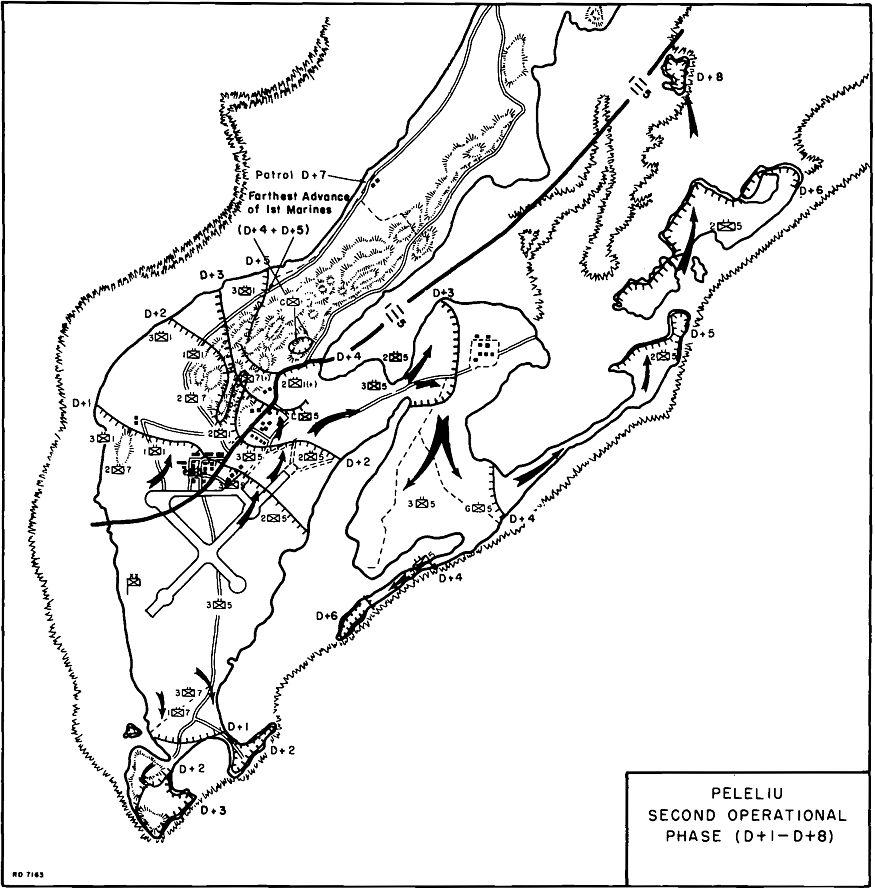
PELELIU
SECOND OPERATIONAL
PHASE (D+1–D+8)
With the counterattack over and the Japanese in apparent disarray, 2/5 immediately resumed its attack, moving north along the eastern half of the airfield. The battalion advanced halfway up the length of the airfield clearing before it stopped to organize for the night. It was the maximum advance of the day, over the most favorable terrain in the division front. It provided needed space for artillery and logistic deployment to support the continuation of the attack the next day.
However, that relatively advanced position had an open right, south, flank which corresponded to a hole in the regimental command structure. At that stage, 3/5 was supposed to maintain the contact between north-facing 2/5 and south-oriented 3/7. But 3/5’s battalion command and control had been completely knocked out by 1700. The battalion executive officer, Major Robert M. Ash, had been killed earlier in the day by a direct hit upon his landing LVT. About the time of the Japanese tank attack, a mortar barrage hit the 3/5 CP in the antitank ditch near the beach, killing several staff and prompting the evacuation of the battalion commander. As of 1700, the three companies of 3/5 were not in contact with each other, nor with the16 battalions to their right and left.
The antitank ditch dug by the Japanese along the center and right of Orange Beaches 1 and 2 soon after the landing became the locations of command posts of various units. Both the 5th Marines’ and 3/5’s CPs were located there, as was the 7th Marines’, shown here. BGen Oliver P. Smith with the advance element of the division CP set up in the ditch also.
Department of Defense Photo (USMC) 94939
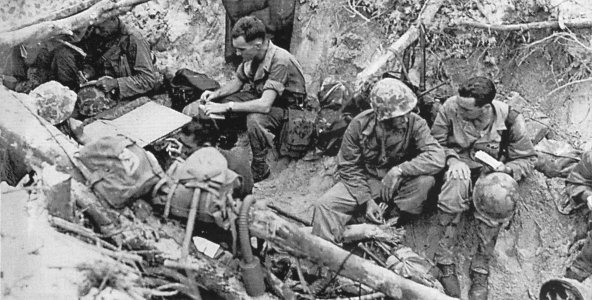
The 5th Marines commanding officer ordered his executive officer, Lieutenant Colonel Lewis W. Walt, to take command of 3/5 and to redeploy so as to close the gap between 5th and 7th Marines. Major Gayle moved 2/5’s reserve company to his right flank and to provide a tie-in position. Walt located and tied in his 3/5 companies to build a more continuous regimental line. By 2230, he had effected the tie-in, just in time. Beginning then, the salient which the 5th Marines had carved between Peleliu’s central and southern defenders came under a series of sharp counterattacks that continued throughout the night. The attacks came from both north and south. None of them enjoyed any notable success, but they were persistent enough to require resupply of ammunition to forward companies. Dawn revealed scores of Japanese bodies north of the Marine lines.
Elsewhere across the 1st Division’s front there were more potentially threatening night counterattacks. None of them succeeded in driving Marines back or in penetrating the lines in significant strength. The most serious attack came against the Company K, 3/1, position on the Point, at the 1st Marines’ left.
In the south, the 7th Marines experienced significant night attacks from the Japanese battalion opposing it. But the Marines there were in comfortable strength, had communications to bring in fire support, including naval gunfire illumination. They turned back all attacks without a crisis developing.
At the end of the first 12 hours ashore, the 1st Marine Division held its beachhead across the intended front. Only in the center did the depth approximate that which had been planned. The position was strong everywhere except on the extreme left flank. General Smith, from his forward command post was in communication with all three regimental commanders. The report he received from Colonel Puller, on the left, did not afford an adequate perception of 1st Marines’ tenuous hold on the Point. That reflected Colonel Puller’s own limited information. The other two regimental reports reflected the situations adequately.
In addition to the three infantry regiments, the 1st Division had almost three battalions of light artillery17 ashore and emplaced. All 30 tanks were ashore. The shore party was functioning on the beach, albeit under full daylight observation by the enemy and under intermittent enemy fire. The division necessarily had to continue at full press on D plus 1. The objective was to capture the commanding crests on the left, to gain maneuver opportunities in the center, and to finish off the isolated defenders in the south.

Caption by the artist, Tom Lea
“This is Sad Sack Calling Charlie Blue We found the battalion commander (LtCol Edward H. Hurst, CO, 3/7) sitting on a smashed wet log in the mud, marking positions on his map. By him sat his radioman, trying to make contact with company commands on the portable set propped up in the mud. There was an infinitely tired and plaintive patience in the radioman’s voice as he called code names, repeating time and again, ‘This is Sad Sack calling Charlie Blue. This is Sad Sack calling Charlie....’”
At least two colonels on Peleliu ended their work day with firm misconceptions of their situations, and with correspondingly inaccurate reports to their superiors. At day’s end, when General Smith finally got a telephone wire into the 1st Marines’ CP, he was told that the regiment had a firm hold on its beachhead, and was approximately on the O-1 objective line. He was not told about, and Colonel Puller was not fully aware of, the gaps in his lines, nor of the gravity of the Company K, 3/1, struggle on the Point, where only 38 Marines were battling to retain the position.
Colonel Nakagawa, on the other hand, had reported that the landing attempt by the Marines had been “put to route.” Inconsistently, he had also reported that his brave counterattack force had thrown the enemy into the sea.
[Sidebar (page 15):]
A Horrible Place
Among the few civilian news correspondents who chose to share the fate of the Marines on shore on Peleliu was Robert “Pepper” Martin, of Time, who furnished the following description of what it was like there:
Peleliu is a horrible place. The heat is stifling and rain falls intermittently—the muggy rain that brings no relief, only greater misery. The coral rocks soak up the heat during the day and it is only slightly cooler at night. Marines are in the finest possible physical condition, but they wilted on Peleliu. By the fourth day there were as many casualties from heat prostration as from wounds....
Peleliu is incomparably worse than Guam in its bloodiness, terror, climate and the incomprehensible tenacity of the Japs. For sheer brutality and fatigue, I think it surpasses anything yet seen in the Pacific, certainly from the standpoint of numbers of troops involved and the time taken to make the island secure.
On the second day, the temperature reached 105 degrees in the shade and there was very little shade in most places where the fighting was going on, and arguably no breeze at all anywhere. It lingered around that level of heat as the days dragged by (temperatures as high as 115 were recorded). Water supply presented a serious problem from the outset. This had been anticipated and in actual fact the solution proved less difficult than expected; the engineers soon discovered that productive wells could be drilled almost anywhere on the comparatively low ground, and personnel semi-permanently stationed near the beach found that even shallow holes dug in the sand would yield an only mildly repulsive liquid which could be purified for drinking with halizone tablets. But it continued necessary to supply the assault troops by means of scoured-out oil drums and five-gallon field cans. Unfortunately, steaming out the oil drums did not remove all the oil, with the result that many or most of the troops drinking water from the drums were sickened. When the captains of the ships in the transport area learned of this and of the shortage of water, they rushed cases of fruit and fruit drinks to the beaches to ease the problem somewhat.
The water situation presented a problem even in the case of troops operating on comparatively level and open ground. Once the fighting entered the ridges, terrain difficult merely to traverse without having to fight, the debility rate shot upward so alarmingly that an emergency call was sent to all the ships off-shore to requisition every available salt tablet for issue to the 1st Marines.
The statement that heat prostrations equalled wound casualties is apt to be misleading. Most of those evacuated were returned to duty after a day or two of rest and rehabilitation; hence, their absence from the frontlines did not permanently impair the combat efficiency of their units. But such numerous cases did strain the already overburdened Medical Corps elements.
[Sidebar (page 16):]
Special Reef-crossing Techniques
Inasmuch as Peleliu’s fringing reef would not permit landing craft within 700 yards of the beach, such craft deposited tanks at the reef’s edge. There the depths permitted tanks to operate in most areas, without being submerged, but not in all. A plan was devised to form tanks into small columns, each to be led by an LVT. So long as the LVT was grounded on the reef, the tanks could follow in trace. But when the LVT encountered a depth which floated it, tanks halted while the LVT literally “felt” out a suitable shallow path. Then the tanks followed, still in small columns, and so arrived at the shore at the earliest possible hour. The technique was one of the keys to timely employment of armor ashore before D-Day was over.
Two other reef-crossing innovations were used on D-Day. A large number of amphibious trailers were incorporated into the logistic plan, to be towed behind landing craft, and later, at reef’s edge they would be taken in tow by amphibian tractors. Ashore, trucks took them into tow, enabling critical supplies to be moved well forward to supply points just in rear of the fighting. Newly available crawler cranes were emplaced on barges near the reef’s edge. They could lift nets full of ammunition and other vital supplies from boats to tractors at the transfer line. Other such crawler cranes were landed early and positioned by the shore party to lift net-loads from LVTs to trucks for expeditious delivery forward.
Department of Defense Photo (USMC) 95624.

Department of Defense Photo (USMC) 95354.
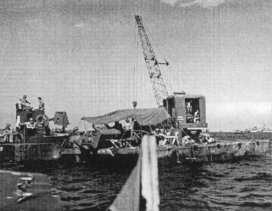
The Assault Continues
With the dawn of a new day, the two opposing commanders at Peleliu awoke from whatever sleep they may have gotten to face immediate grim prospects.
General Rupertus, having been frustrated by his earlier effort to land his division reserve into the southern sector of his beachhead, was now aware that his northern sector stood most in need of help, specifically on the extreme left flank. Rupertus ordered 2/7 into Puller’s sector for employment there.
Wary riflemen of the 5th Marines advance through a devastated Japanese bivouac area to the northeast of the Peleliu airfield. The concealed enemy troops took full advantage of the rocky terrain, forcing the Marines to clear out each nook and cranny.
Department of Defense Photo (USMC) 96763

At division headquarters afloat,18 more had been learned about the extent of Marine D-Day casualties: 1,111, of whom 209 were killed in action (KIA). While this was not a hefty percentage of the total reinforced divisional strength, the number was grim in terms of cutting-edge strength. Most of those 1,111 casualties had been suffered in eight of the division’s nine infantry battalions. Except in the center, Rupertus was not yet on the O-1 line, the first of eight planned phase lines.
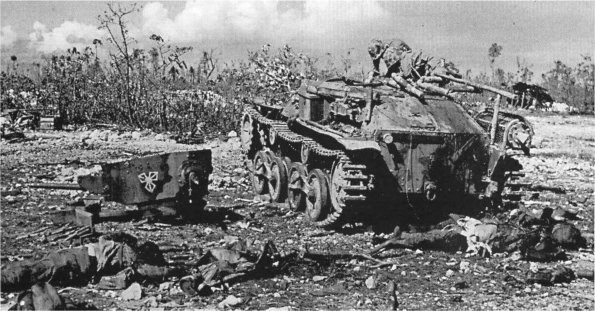
Department of Defense Photo (USMC) 95921
At about 1650 on D-Day, Col Nakagawa launched his tank-infantry attack from the north of the airfield and headed south across the front of the 1st Marines’ lines. The 1st Marine Division had been prepared for such an eventuality, and the attack was a total failure. More than 100 enemy tanks and their covering troops were reported as being literally blown apart.
Having received less than a comprehensive view of the 1st Marines’ situation, Rupertus was more determined than ever to move ashore quickly, to see what he could, and to do whatever he could to re-ignite the lost momentum. That he would have to operate with a gimpy leg from a sandy trench within a beach area still under light but frequent fire, seemed less a consideration to him than his need to see and to know (General Rupertus had broken his ankle in a preassault training exercise, and his foot was in a cast for the entire operation.).
Over on Colonel Nakagawa’s side, despite the incredible reports being sent out from his headquarters, he could see from his high ground a quite different situation. The landing force had not been “put to route.” Ashore, and under his view, was a division of American Marines deployed across two miles of beachhead. They had been punished on D-Day, but were preparing to renew the fight. Predictably, their attack would be launched behind a hail of naval gunfire, artillery, and aerial attacks. They would be supported by U.S. tanks which had so readily dispatched the Japanese armor on D-Day.
Apparently covered by a returning 1st Marine Division veteran’s graffiti, this Japanese light tank remains on the northwest corner of the Peleliu airfield. Its turret blown off, it is the only one left from the failed enemy attack of 1944.
Caption and photo by Phillip D. Orr
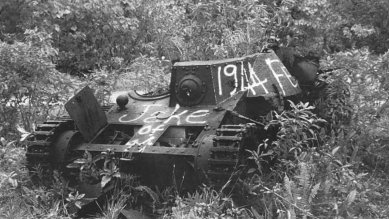
In his own D-Day counterattack, Nakagawa had lost roughly one of19 his five infantry battalions. Elsewhere he had lost hundreds of his beach defenders in fighting across the front throughout D-Day, and in his uniformly unsuccessful night attacks against the beachhead. Nevertheless, he still had several thousand determined warriors, trained and armed. They were deployed throughout strong and well-protected defensive complexes and fortifications, with ample underground support facilities. All were armed with the discipline and determination to kill many Americans.
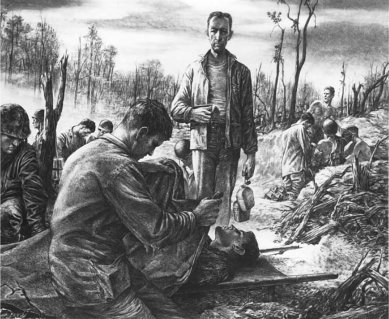
Caption and photo by Phillip D. Orr.
“Sick Bay in a Shellhole: The Padre Read, ‘I am the Resurrection and the Light’ About thirty paces back of the Jap trench a sick bay had been established in a big shell crater made by one of our battleship guns.... In the center of the crater at the bottom a doctor was working on the worst of the stretcher cases. Corpsmen, four to a stretcher, came in continually with their bloody loads.... The padre stood by with two canteens and a Bible, helping. He was deeply and visibly moved by the patient suffering and death. He looked very lonely, very close to God, as he bent over the shattered men so far from home.”
As he had known from the start, Nakagawa’s advantage lay in the terrain, and in his occupation and organization of that terrain. For the present, and until that time when he would be driven from the Umurbrogol crests which commanded the airfield clearing, he held a dominating position. He had impressive observation over his attackers, and hidden fire to strike with dangerous effect. His forces were largely invisible to the Americans, and relatively impervious to their fire superiority. His prospects for continuing to hold key terrain components seemed good.
The Marines were attacking fortified positions, against which careful and precise fire preparations were needed. They were, especially on the left, under extreme pressure to assault rapidly, with more emphasis upon speed than upon careful preparation. With enemy observation and weapons dominating the entire Marine position, staying in place was to invite being picked off at the hidden enemy’s leisure. General Rupertus’ concern for momentum remained valid.
This placed the burden of rapid advance primarily upon the 1st Marines on the left, and secondarily upon the 5th in the airfield area. In the south, the 7th Marines already held its edge of the airfield’s terrain. The scrub jungle largely screened the regiment from observation and it was opposed by defenses oriented toward the sea, away from the airfield.
Puller’s 1st Marines, which had already suffered the most casualties on D-Day, still faced the toughest terrain and positions. It had to attack, relieve Company K, 3/1, on the Point, and assault the ridges of Umurbrogol, south to north. Supporting that assault, Honsowetz had to swing his east-facing 2/1 leftward, and to capture and clear the built-up area between the airfield and the ridges. This his battalion did on D plus 1 and 2, with the 5th Marines assisting in its zone on the right. But then he was at the foot of the commanding ridges, and joined in the deadly claw-scratch-and-scramble attack of Davis’ 1/1 against the Japanese on and in the ridges.
As Colonel Puller was able to close the gaps on his left, and swing his entire regiment toward the north, he pivoted on Sabol’s 3/1 on the left. Sabol, aided by Company B, 1/1, established contact with and reinforced Company K on the Point. Then he headed north, with his left on the beach and his right near the West Road along the foot of the westernmost features of the Umurbrogol complex. In Sabol’s sector, the terrain permitted tank support, and offered more chances for maneuver than were afforded in the ridges further to the right. Hard fighting was involved, but after D-Day, Sabol’s battalion was able to move north faster than the units on his right. His advance against the enemy was limited by the necessity to keep contact with Davis’ 1/1 on his right.
The relative rates of movement along the boundary between Sabol’s flatter and more open zone and Davis’ very rough zone of action, brought the first pressing need for reserves. Tactically, there was clear necessity to press east into and over20 the rough terrain, and systematically reduce the complex defenses. That job Davis’ 1/1, Honsowetz’s 2/1, and Berger’s 2/7 did. But more troops than Sabol had also were needed to advance north through the open terrain to begin encirclement of the rough Umurbrogol area, and to find avenues into the puzzle of that rugged landscape. By 17 September, reserves were badly needed along the 1st Division’s left (west) axis of advance. But on 17 September, neither the division nor III Amphibious Corps had reserves.
As Sabol’s 3/1 fought up the easier terrain on the 1st Marines’ left, Davis’ 1/1 drove into the center with his left on the break between coral ridge country and Sabol’s more open flat zone. Among his early surprises, as he approached the foot of the ridge area, was another of the blockhouses Admiral Oldendorf had reportedly destroyed with pre-D-Day gunfire. Although it had been on the planning map for weeks, those who first encountered it, reported the emplacement as “not having a mark on it!”
The blockhouse was part of an impressive defense complex. It was connected to and supported by a web of pillboxes and emplacements, which it in turn supported. The walls were four-feet thick, of reinforced concrete. Happily, Davis was given a naval gunfire support team which called in the fires of the USS Mississippi. Between them, they made fairly short work of the entire complex, and 1/1 could advance until it ran into the far more insoluble Japanese ridge defense systems.
Major Davis, who was to earn a Medal of Honor in the Korean War in 1950, said of the attack into and along or across those ridges, “It was the most difficult assignment I have ever seen.”
During the 1st Marines’ action in the first four days of the campaign, all three of its battalions battled alongside, and up onto Umurbrogol’s terrible, cave-filled, coral ridges. Berger’s 2/7, initially in division reserve, but assigned to the 1st Marines on D plus 1, was immediately thrown into the struggle. Puller fed two separate companies of the battalion into the fight piecemeal. Shortly thereafter, 2/7 was given a central zone of action between Colonel Puller’s 1st and 2d Battalions. The 1st Marines continued attacking on a four-battalion front about a 1,000 yards wide, against stubborn and able defenders in underground caves and fortifications within an incredible jumble of ridges and cliffs. Every advance opened the advancing Marines to new fire from heretofore hidden positions on flanks, in rear, in caves above or below newly won ground.
Nothing better illustrated the tactical dilemmas posed by Umurbrogol than did the 19 September seizure of, then withdrawal from, Hill 100, a ridge bordering the so-called Horseshoe Valley at the eastern limit of the Pocket. It lay in the sector of Lieutenant Colonel Honsowetz’ 2d Battalion, 1st Marines, to which Company B of Major Ray Davis’ 1st Battalion was attached. Company B, 1/1, having landed with 242 men, had 90 men left when its commander, Captain Everett P. Pope, received Honsowetz’ order to take what the Marines were then calling Hill 100. The Japanese called it Higashiyama (East Mountain).
Initially supported by tanks, Pope’s company lost that support when the two leading tanks slipped off an approach causeway. Continuing with only mortar support, and into the face of heavy defending mortar and machine-gun fire, Pope’s Marines21 reached the summit near twilight, only to discover that the ridge’s northeast extension led to still higher ground, from which its defenders were pouring fire upon the contested Hill 100. Equally threatening was fire from the enemy caves inside the parallel ridge to the west, called Five Brothers. In the settling darkness Pope’s men, liberally supported by 2/1’s heavy mortars, were able to hang on. Throughout the night, there was a series of enemy probes and counterattacks onto the ridge top. They were beaten off by the supporting mortars and by hand-to-hand brawls involving not only rifles but also knives, and even rocks, thrown intermittently with grenades, as supplies of them ran low. Pope’s men were still clinging to the ridge top when dawn broke; but the number of unwounded Marines was by now down to eight. Pope was ordered to withdraw and was able to take his wounded out. But the dead he had to leave on the ridge, not to be recovered until 3 October, when the ridge was finally recaptured for good. This action was illustrative and prophetic of the Japanese defenders’ skillful use of mutually supporting positions throughout Umurbrogol.
By D plus 4, the 1st Marines was a regiment in name only, having suffered 1,500 casualties. This fact led to a serious disagreement between General Rupertus, who kept urging Puller onward, and the general’s superior, Major General Roy S. Geiger, III Amphibious Corps commander. Based on his own experiences in commanding major ground operations at Bougainville and Guam, Geiger was very aware of the lowered combat efficiency such losses impose upon a committed combat unit.
On 21 September, after visiting Colonel Puller in his forward CP and observing his exhausted condition, and that of his troops, Geiger conferred in the 1st Division CP with Rupertus and some of his staff. Rupertus was still not willing to admit that his division needed reinforcement, but Geiger overruled him. He ordered the newly available 321st Regiment Combat Team (RCT), 81st Infantry Division, then on Angaur, to be attached to the Marine division. Geiger further ordered Rupertus to stand down the 1st Marines, and to send them back to Pavuvu, the division’s rear area base in the Russell Islands.
On 21 September (D plus 5), Rupertus had ordered his 7th Marines to relieve what was left of the 1st and 2d Battalions of the 1st Marines. By then, the 1st Marines was reporting 1,749 casualties. It reported killing an estimated 3,942 Japanese, the capture of 10 defended coral ridges, the destruction of three blockhouses, 22 pillboxes, 13 antitank guns, and 144 defended caves.
Near the edge of a clearing, a Marine rifleman fires a rifle grenade with good effect into an enemy position up ahead into the northern, difficult portion of Peleliu.
Department of Defense Photo (USMC) 96106
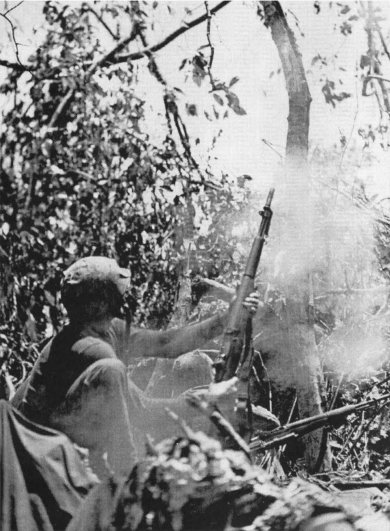
In that fighting the assault battalions had captured much of the crest required to deny the enemy observation and effective fire on the airfield and logistic areas. Light aircraft had begun operating on D plus 5 from Peleliu’s scarred, and still-under-22repair airfield. With Purple Beach in American control, the division’s logistical life-line was assured. Although the Japanese still had some observation over the now operating airfield and rear areas, their reduced capability was to harass rather than to threaten.
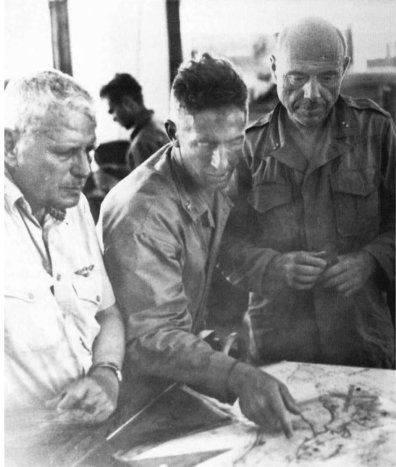
Department of Defense Photo (USMC) 95661
At a conference held in the 1st Marine Division command post, Col Harold D. “Bucky” Harris, 5th Marines commander, center, explains to MajGen Roy S. Geiger, Commanding General, III Amphibious Corps, left, and MajGen William H. Rupertus, commander of the division, his plan of operations in northern Peleliu.
Furthermore, the Marine front lines in the Umurbrogol had by now reached close to what proved to be the final Japanese defensive positions. Intelligence then available didn’t tell that, but the terrain and situation suggested that the assault requirements had been met, and that in the Umurbrogol it was time for siege tactics. The Japanese defenders also learned that when aerial observers were overhead, they were no longer free to run their weapons out of their caves and fire barrages toward the beach or toward the airfield. When they tried to get off more than a round or two, they could count on quick counter-battery, or a much-dreaded aerial attack from carrier-based planes, or—after 24 September—from Marine attack planes operating from the field on Peleliu.
[Sidebar (page 20):]
A Paucity of Reserves
Planning for the seizure of the southern Palaus (Angaur and Peleliu-Ngesebus) had been the responsibility of III Amphibious Corps (Major General Roy S. Geiger). But General Geiger and his staff had been fully occupied during the critical planning weeks, up to and including the capture of Guam, from 21 July to 10 August. The Guam operation ended more than a month later than originally contemplated. Meanwhile, someone else had to fill the corps planning function for the Palau undertaking. A temporary headquarters, X-Ray Corps, under Major General Julian C. Smith was established. The two major tactical tasks of the southern Palau operation were assigned to the Army 81st Infantry Division (Angaur) and 1st Marine Division (Peleliu-Ngesebus). The 81st Division was also tasked to set aside one RCT as corps reserve.
This partition of division level-planning effort was convenient, but it slipped into a gross imbalance in force allocation which was neither recognized nor corrected as plans progressed toward operations. The 1st Marine Division had nine infantry battalions with which to attack more than 10,000 defending Japanese on Peleliu. Major General Paul J. Mueller’s 81st Infantry Division had six infantry battalions with which to attack 1,500 (earlier reported as 2,500) Japanese defenders on Angaur. Terrain and circumstances on the two objective islands were similarly imbalanced. Peleliu was considerably larger and had far more complex terrain. Its defensive fortifications were obviously far more developed, and it offered fewer predictable landing beaches than Angaur. Only the subsequent rapid shifting of plans and higher-level responsibilities can account for such force allocation imbalance not having been corrected at Corps or Expeditionary Troops level. The effect of all these imbalances was still further magnified between 13 and 17 September. Higher level changes in plans and naval decisions stripped III Corps of all its reserves.
The Early Battle in the Division Center
On D plus 1, when the 1st Marines had launched their costly Umurbrogol assault, the 5th Marines on its right also faced an assault situation, but one of substantially less opposition and easier terrain. Lieutenant Colonel Boyd’s 1/5 had to fight across the airfield, from southwest to northeast, and through the built-up area similar to that which faced Honsowetz’s 2/1. The battalion was subjected to observed fire from the Umurbrogol and to small arms fire from Japanese defenders in the rubble-filled built-up area. Boyd’s coordinated tank-infantry attack quickly carried the day. He soon had control of that area, and the east-west, cross-island road, which could lead the 5th toward its next objective, the eastern peninsula of Peleliu.
On the 5th Marines’ right, 2/5 had a more difficult time. Its progress was stubbornly opposed by infantry from the woods on its right, and by artillery from Umurbrogol, which took a particular interest in the tanks 2/5 was using to support its attack along the edge of the woods. Whether the Japanese infantry in those woods had been posted to defend that position, or whether they were just surviving Japanese infantry from the D-Day counterattack, was never established. The fight took all day and inflicted heavier casualties on Gayle’s battalion than had D-Day. By dusk, 2/5 had battled beyond the north end of the airfield, and halted for the night near the woods concealing the approaches to the eastern peninsula.
As the two-battalion attack of the 5th Marines (D plus 1) was heavily engaged on its front and right, the regimental headquarters near the beach was hit by an artillery barrage which, coupled with D-Day’s loss of 3/5’s commanding officer and executive officer, engendered a significant rearrangement in command assignments. The early D plus 1 barrage hit the regimental CP, took out numbers of the staff, and buried the regimental commander in the crumbling Japanese antitank trench in which the CP was “sheltered.” Fortunately, the23 burial was temporary, and Colonel Harris emerged with a twisted and battered leg, but still able to hobble. Two of his principal staff officers were casualties, and his sergeant major killed. Harris elected not to be evacuated, but he needed help in the regimental CP. Ordering Lieutenant Colonel Walt back from the 3d Battalion to the regimental CP, Harris directed the commanding officer of 2/5 to send his executive officer, Major John H. Gustafson, to take command of 3/5. Then Harris directed Boyd to send his 1/5 operations officer, Major Hierome Opie, to join 3/5 as Gustafson’s executive officer.
Fortunately, 3/5 was having a relatively quiet day, unlike its hair-raising regrouping on the night of D-Day. After daylight, as 2/5 attacked north, 3/5 stretched along the east edge of the mangrove lagoon which separated Peleliu from the eastern peninsula. In that position, 3/5 also tied into 3/7 as that battalion attacked south. Thus 3/5 protected each regiment’s flank against any Japanese movement across the intervening water, and into the rear of the attacking battalions. No such threat developed, and as the afternoon grew on, there emerged a more pressing employment for 3/5.
As Walt returned to his post beside the now only semi-mobile Harris, Major Gustafson was told to get 3/5 into position to bolster and then relieve 1/5, as it closed in on its O-2 objectives.
Throughout the next day (D plus 2), the 5th Marines kept tied in with the 1st Marines on its left and captured some control of the foot of the East Road. On the right, 2/5 hacked and combed its way through the jungle and mangrove north of the airfield, alongside the road leading toward the eastern peninsula. The thick scrub, nearly impenetrable, reduced progress to a crawl. It compensated by concealing most of the advancing Marines from enemy observation from high ground to 2/5’s north and northwest.
That 5th Marines’ forward position generally coincided with the northeast sector of the airfield earlier mentioned. Possession of that visual boundary meant that in most places on the regimental right, frontline Marines were spared the hostile observation and directed fire from Umurbrogol. As with the 7th Marines, largely hidden in the jungle of the south, this lessened the need for headlong assault. There would now be freedom to maneuver more deliberately and to coordinate supporting fire more carefully.
The 7th Marines’ Complete Destruction of Enemy in the South
In the south, from D plus 1 through D plus 3, the 7th Marines was in vigorous assault against extensive fortifications in the rear of the Scarlet Beaches. These were defended by a full battalion, the elite 2d Battalion, 15th Regiment. Although isolated and surrounded by the Marines, this battalion demonstrated its skill and its understanding of Colonel Nakagawa’s orders and mission: to sell Peleliu at the highest possible price. The 7th Marines attacked with 3/7 on the left and 1/7 on the right. They enjoyed the advantage of attacking the extensive and well-prepared defenses from the rear, and they had both heavy fire support and the terrain for limited maneuver in their favor. Both sides fought bitterly, but by 1530 on 18 September (D plus 3), the battle was substantially over. The Marines had destroyed an elite Japanese reinforced infantry battalion well positioned in a heavily fortified stronghold. Colonel Hanneken reported to General Rupertus that the 7th Marines’ objectives he had set for D-Day were all in hand. The naval gunfire preparation had been significantly less than planned. The difference had been made up by time, and by the courage, skill, and additional casualties of the infantry companies of 1/7 and 3/7.
Now the 7th Marines, whose 2d Battalion was already in the thick of the fight for Umurbrogol, was about to move out of its own successful battle area and into a costly assault which, by this time, might have been more economically conducted as a siege.
Maneuver and Opportunity
As the 7th Marines moved to its mission, the 5th Marines was again successfully opening up opportunities on Peleliu’s eastern, “lobster claw” peninsula. Most of those opportunities, unfortunately were never exploited.
By the end of D plus 2, the 5th Marines stood at the approach to the eastern peninsula, and astride the East Road just east of the 1st Marines’ terrible struggle in Umurbrogol. It had fought somewhat clear of the galling fires from Umurbrogol, and planned an assault on the eastern peninsula across a narrow causeway, which the Japanese should certainly defend. Then a D plus 3 reconnaissance of the causeway revealed that the causeway was not defended. The 2d Battalion hastened to seize the opportunity and moved across in strength. The attack was hit by its own supporting fires. The forward battalion CP group was strafed by Navy planes and then hit by artillery airburst, causing the loss of 18 battalion headquarters personnel to “friendly fire.”
Nevertheless, a bridgehead across the causeway was well established on D plus 3, and the 5th Marines’ Colonel Harris moved to exploit it. During the afternoon, he thinned his forces holding the East Road sector, gave the former 3/5 mission to Company L, 3/5, and gave the remainder of 3/5 a new mission. He ordered Gustafson into a position within the bridgehead established by 2/5, and further ordered both battalions then to capture and clear the eastern peninsula. Earlier he had expected24 such an attack to be against the strong defending forces originally reported on the eastern peninsula. However, the apparent reduction of defending forces now appeared to offer an opportunity to seize Purple Beach quickly, a logistic prize of some significance. Harris knew that the division would need to shift its logistical axis to Purple Beach, away from the fire from Umurbrogol, and away from the threat of westerly storms.
Before dark, Gustafson moved two of his 3/5 companies across the causeway, and moved his own CP group in with the 2/5 CP, where the two commanders jointly planned the next day’s advance. Hoping for little resistance, they directed rapid movement, but armed their point units with war dog sections to guard against ambush. Their lead companies moved out just after dawn. In the 3/5 sector, there was an ambush, but the war dogs warned of, and effectively thwarted, the attempted surprise.
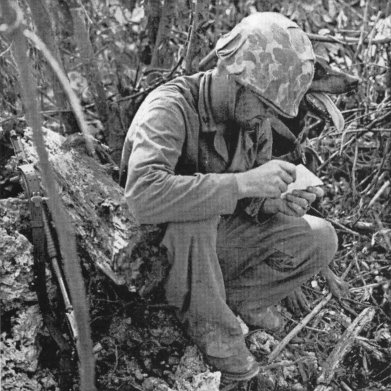
Department of Defense Photo (USMC) 96936
A Marine war dog handler reads a note just delivered by canine messenger, a Doberman Pinscher, one of the breeds used in the Pacific. This Marine has a pump shotgun.
By the end of D plus 4, the two battalions had cleared the main body of the eastern peninsula and had reached Purple Beach from the rear. The defenses were most impressive, but many were unmanned. Those enemy troops encountered seemed more interested in hiding than in fighting, leading to speculation that Nakagawa’s trained infantry had been moved west to the fight on D-Day and/or D plus 1. By D plus 5, Purple Beach was cleared, as were the long peninsulas southwest and northeast of Purple Beach. On D plus 6, 2/5 seized the two islands immediately north of the northeast peninsula, and the next day occupied the small unnamed islet just 1,000 yards east of the northern ridges of Peleliu.
From that position, and positions elsewhere on the other islands, and near Ngardololok, there appeared to be many opportunities to attack by fire against the cave-infested north-south ridges of central and northern Peleliu. Such positioning of heavy weapons would be very difficult, but relative to the intense infantry battles underway in Umurbrogol, such difficulties seemed acceptable. Many of the prospective targets could have been vulnerable to direct, flat trajectory fire across the front of U.S. units advancing north in central Peleliu. Corps artillery units had conducted such direct fire training before embarking for the Peleliu campaign. Such tactical advantages and opportunities from the eastern peninsula were advocated but never exploited. Only later, in the fighting for northern Peleliu was the 5th Marines able to secure point-blank, heavy, single-gun fire support.
Encirclement of the Umurbrogol Pocket
With southern and eastern Peleliu captured, there now began an encirclement of the Japanese defenders in central Peleliu, and an attack against the Japanese defending northern Peleliu and nearby Ngesebus and Kongauru. This was the obvious next tactical phase for combat on Peleliu. However, securing it was less necessary for the basic Peleliu tactical and strategic goals than for the mopping-up of the island. As the 1st Marine Division’s Assistant Commander, Brigadier General Oliver P. Smith, later phrased it, “by the end of the first week, the Division had control of everything on the island that it then needed, or later used.”
The airfield had been seized, was under repair and improvement, and in use. It was no longer any threat, if it had ever been, to MacArthur’s long-heralded return to the Philippines. Peleliu’s best logistical beach (Purple) had been secured, providing a secure logistic axis to the main battle areas. The Japanese defenders in25 their caves, and in northern Peleliu and on Ngesebus, retained some capability to harass American rear installations, but that was sharply curtailed by the Marines’ counterfire.
Only two significant Japanese capabilities remained: they could bitterly resist from their cave positions and they had a limited capability to reinforce Peleliu from Babelthuap. Such reinforcement could only be by small-unit infiltration, which faced U.S. naval screening operations in the area. Likewise, American encirclement of the stubborn Umurbrogol Pocket faced two obstacles. First was the lack of additional maneuver regiments from III Amphibious Corps’ reserve. General Geiger in fact had no corps reserve pending the release of some units from the forces involved in the seizure of Angaur. That landing by the 81st Infantry Division (less the 323d RCT) had been launched on 17 September, after which there was no corps reserve.
The operation on Angaur, the planning which attended it and the decision on its timing, impacted heavily upon the Peleliu operation. The naval planners early on proposed landing on Angaur before Peleliu. Only when Major General Julian C. Smith, commanding Expeditionary Troops/X-Ray Planning Group, explained that such timing would invite the numerous Japanese in northern Palau to reinforce Peleliu was it agreed that Angaur be assaulted only after the Peleliu landing was assured of success. However, the Angaur landing was initiated before the Peleliu landing had been clearly resolved. The commanding general of the 81st Division wanted to land as soon as possible, and he was supported in his view by his naval task unit commander, Rear Admiral William H. P. Blandy. Opposing the 17 September date for the Angaur landing was Marine Major General Julian Smith. Smith argued that committing the element of III Corps Reserve before the Peleliu operation was more fully developed would be premature. His advice was ignored by Vice Admiral Theodore S. Wilkinson.
A related decision on 17 September committed the III Corps’ final reserve to the Ulithi landing. The task was assigned to the Western Attack Force, which was ordered to seize Ulithi with “available resources.” Over General Smith’s advice, Wilkinson chose to commit the entire 323d RCT, the 81st Division’s other maneuver element. The 321st subsequently and successfully occupied an undefended Ulithi while reserves were sorely needed at Peleliu.
By 20 September, the 81st Division had defeated or cornered all survivors of Angaur’s 1,400 defenders. The 81st’s commander declared Angaur secure. He tasked his 322d RCT to complete the mop-up, and reported to General Geiger that the 321st RCT was available for further operations. The lack of enough troops to begin encircling Umurbrogol was no longer an obstacle.
The other obstacle to reinforcing the division on Peleliu and encircling the Pocket lay in the thinking of General Rupertus, who clung to a belief that his Marines could do it without help from the Army. The III Corps plan tasked the 81st Division to reinforce the Marines in seizing Peleliu and then to relieve the 1st Marine Division for the mop up, but the general continued to exhort his commanders to “hurry up.”
Earlier, General Rupertus and Colonel Puller had shrugged off a suggestion from the 5th Marines’ “Bucky” Harris that they take a look at the Umurbrogol Pocket from the newly available light planes of Marine Observation Squadron 3. Harris’ own aerial reconnaissance, made immediately after those planes arrived on 19 September, had altered his view of the Umurbrogol from sober to grave. It convinced him that attacking the Pocket from the north would be less costly than the originally planned and ordered attempts from south to north. Both Puller and Rupertus responded to Harris that they had their maps.
Once the troops entered the Umurbrogol Mountain, they found sinkholes and difficult terrain much as pictured here. Japanese soldiers in the caves and heights above could fire at will at the Marines, who were like so many “fish in a barrel.”
Department of Defense Photo (USMC) 108432
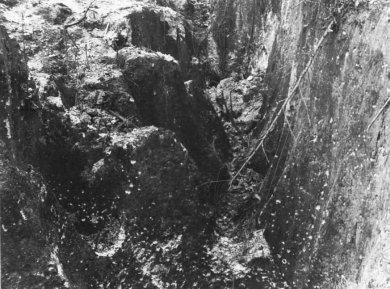
The prelanding scheme of maneuver was built on the tactical concept that, after capturing the airfield, the26 1st Marine Division would push north along a line across the width of the main or western part of the island. Once abreast of the southern edge of Umurbrogol, that concept and maneuver scheme were reflected in a series of four west-to-east phase lines, indicating an expected linear advance, south to north. Clearly, it was expected that the advance along the flatter zones west and east of Umurbrogol would be at approximately the same pace as that along the high-central ground of Peleliu. Such thinking may have been consistent with Rupertus’ prediction of a three-day assault. Developments in Sabol’s sector to the west, and in the 5th Marines’ sector to the east, apparently did not change division-level thinking. Until additional forces became available, such a linear advance may have seemed all that was possible.
Even so, there was no apparent reexamination of the planned south-to-north linear advance, and for days after the Pocket was sealed off at its northernmost extremity, the division commander kept ordering attacks from south to north, generally following the initial landing plan. As had been revealed to “Bucky” Harris in his early aerial reconnaissance of the Umurbrogol Pocket, such attacks would offer little but casualties. Troops, heavily supported, could advance into “the Horseshoe” and into “Death Valley,” but the positions they reached then proved untenable and withdrawal was usual at day’s end.
Some part of this thinking may have well come from the inadequacies of the map in use. The 5th Marines in early October produced a new and more representative sketch map. It located and identified the details within Umurbrogol sufficiently to facilitate maneuver and fire coordination.
That mapping effort, incidentally, led to the misnaming of Honsowetz’ Hill 100, where Captain Everett P. Pope earned his Medal of Honor. The 5th’s mapping team, launched after Harris’ regiment was committed against the Pocket, encountered Lieutenant Colonel Walt, the regimental executive officer, on Hill 100 during their sketching, and so named the hill.
Even after General Geiger had ordered General Rupertus on 21 September to stand down Puller’s shattered 1st Marines, General Rupertus expressed the belief that his Marines, alone, would shortly clear the entire island. After taking a closer look at the situation on the ground, Geiger ordered RCT 321 from Angaur and attached it to the Marine division. Encirclement of the Umurbrogol Pocket now became tactically feasible.
Capture of northern Peleliu and Ngesebus became more pressing with the discovery on 23 September that some part of the enemy’s substantial troop strength in the northern Palaus was being infiltrated by barge from Koror and Babelthuap into northern Peleliu.
Although the naval patrol set to protect against just that reinforcing action had discovered and destroyed some of the Japanese barges, most enemy troops seemed to have waded ashore on the early morning of 23 September. Colonel Nakagawa suddenly had reinforcements in the form of a partially mauled infantry battalion in northern Peleliu.
Encirclement of Umurbrogol and Seizure of Northern Peleliu
A plan to encircle the Pocket, and deny reinforcement to northern Peleliu was immediately formulated. General Rupertus’ staff was closely attended by selected III Corps staff officers, and General Geiger also was present.
The plan called for two regiments to move up the West Road, the Army 321st Infantry leading in the attack, and the 5th Marines following. The Marines were to pass through the Army unit after it had gone beyond the Pocket on its right, and the 5th would continue then to take northern Peleliu and Ngesebus.
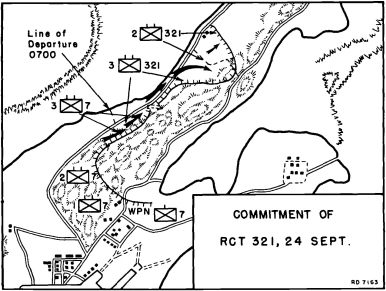
COMMITMENT OF
RCT 321, 24 SEPT.
The 321st RCT, by now battle tested, was tasked to push up the West Road, alongside and just atop the western edge of coral uplift which marked the topographical boundary between the flat western plain, and the uplifted coral “plateau.” That plateau, about 300 yards west to east,27 constituted the western shoulder of the Pocket. The plateau rose some 30–80 feet above the West Road. Its western edge, or “cliff,” was a jumble of knobs and small ridges which dominated the West Road, and would have to be seized and cleared to permit unharrassed use of the road.
Once the 321st RCT was past this up-lift, and the Pocket which it bounded, it was to probe east in search of any routes east through the 600 yards necessary to reach the eastern edge of that portion of Peleliu. Any opportunities in that direction were to be exploited to encircle the Pocket on the north.
Behind the 321st RCT, the 5th Marines followed, pressed through, and attacked into northern Peleliu. Hanneken’s 7th Marines relieved the 1st, which was standing down to the eastern peninsula, also relieving the 5th Marines of their then-passive security role. The 5th was then tasked to capture northern Peleliu, and to seize Ngesebus-Kongauru.
This maneuver would involve the use of the West Road, first as a tactical route north, then as the line of communications for continued operations to the north. The road was comparatively “open” for a distance about halfway, 400 yards, to the northern limit of the Pocket, and paralleled by the ragged “cliff” which constituted the western shoulder of the up-lifted “plateau.” That feature was no level plateau, but a veritable moonscape of coral knobs, karst, and sinkholes. It had no defined ridges or pattern. The sinkholes varied from room-size to house-size, 10 to 30 feet in depth, and jungle- and vine-covered. The “plateau” was generally 30 to 100 feet above the plain of the road. Some 200–300 yards further to the east, it dropped precipitiously off into a sheer cliff, called the China Wall by those Marines who looked up to it from the southern and eastern approaches to the Pocket. To them, that wall was the western edge of the Pocket and the coral “plateau” was a virtually impassable shoulder of the Pocket.
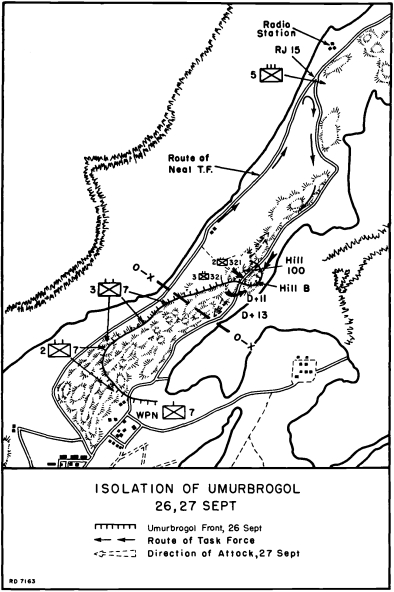
ISOLATION OF UMURBROGOL
26, 27 SEPT
The plateau was totally impenetrable by vehicles. The coral sinkholes and uplifted knobs forced any infantry moving through to crawl, climb, or clamber down into successive small terrain compartments of rough and jagged surfaces. Evacuating any casualties would involve unavoidable rough handling of stretchers and their wounded passengers. The area was occupied and defended by scattered small units and individuals who did not sally forth, and who bitterly resisted movement into their moonscape. When Americans moved along the West Road, these Japanese ignored individuals, took under fire only groups or individuals which appeared to them to be rich targets.
The only tactical option along the West Road was to seize and hold the coral spires and cliffs commanding the road, and to defend such positions against infiltrators. Once those heights were seized, troop units and28 trucks could move along West Road. Until seized, the “cliff” offered concealment and some cover to occupying Japanese. Until those cliff positions were seized and held, the Japanese therein could be only temporarily silenced by heavy firepower. Until they were driven from their commanding positions, the road could not be treated as truly open.
Those terrain conditions existed for three-quarters of a mile along the West Road. There, abreast the north end of the Pocket, the plateau of coral sinkholes merged into a more systematic group of limestone ridges. These ridges trended slightly northeast, broadening the coastal strip to an east-west width of 200 to 400 yards.
Into that milieu, the 321st RCT was launched on 23 September, behind an hour-long intensive naval gunfire and artillery preparation against the high ground commanding the West Road. The initial Army reconnaissance patrols moved generally west of the road, somewhat screened from any Japanese still on the “cliff” just east of the road by vegetation and small terrain features. These tactics worked until larger units of the 2d Battalion, 321st, moved out astride the West Road. Then they experienced galling fire from the heights above the road.
The 321st’s 2d Battalion had relieved 3d Battalion, 1st Marines, along an east-west line across the road, and up onto the heights just above the road. Near that point, the 1st Marines had been tied into the forward left flank of 3d Battalion, 7th Marines. The orders for the advance called for 3/7 to follow behind the elements of 2/321, along the high ground as the soldiers seized the succeeding west edge of the cliff and advanced northward. However, the advanced elements along the ridge were immediately out-paced by the other 2/321 elements in the flat to their west. Instead of fighting north to seize the ridge, units responsible for that cliff abandoned it, side-stepping down to the road. They then advanced along the road, and soon reported that 3/7 was not keeping contact along the high ground.

Caption and photo by Phillip D. Orr
Discovered during a trip to Peleliu in 1994 was this 1,000-man cave, littered with empty sake bottles, deep in the tunnels in the Amiangal Mountain in north Peleliu.
On orders from Colonel Hanneken, the 7th Marines’ commanding officer, 3/7 then captured the high ground which 2/321 had abandoned, but at a cost which did little for inter-service relations. Thereafter, 3/7 was gradually further committed along the ridge within the 321st zone of action. This of course stretched 3/7, which still had to maintain contact on its right in the 7th Marines’ zone, generally facing the southern shoulders of the Umurbrogol Pocket. Further north, as the 321st pressed on, it was able to regain some of the heights above its axis of advance, and thereafter held onto them.
Abreast the northern end of Umurbrogol Pocket, where the sinkhole terrain blended into more regular ridgelines, the 321st captured parts of a key feature, Hill 100. Together with an adjacent hill just east of East Road, and designated Hill B, that position constituted the northern cap of the Umurbrogol Pocket. Seizing Hill B, and consolidating the partial hold on Hill 100 would occupy the 321st for the next three days.
As the regiment probed this eastern path across the north end of Umurbrogol, it also pushed patrols north up the West Road. In the vicinity of the buildings designated “Radio Station,” it reached a promising road junction. It was in fact the junction of West and East Roads. Colonel Robert F. Dark, commanding officer of RCT 321, determined to exploit that route, back south, to add a new direction to his attack upon Hill 100/Hill B. He organized a mobile task force heavy in armor and flamethrowers, designated Task29 Force Neal, named for Captain George C. Neal. He sent it circling southeast and south to join 2/321’s efforts at the Hill 100/Hill B scene. Below that battle, the 7th Marines continued pressure on the south and east fronts of the Pocket, but still attacking south to north.
As those efforts were underway, the 5th Marines was ordered into the developing campaign for northern Peleliu. Now relieved by the 1st Marines of its passive security mission on the eastern peninsula and its nearby three small islands, the 5th moved over the West Road to side-step the 321st action and seize northern Peleliu. Having received the division order at 1100, the 5th motored, marched, and waded (off the northeastern islets) to and along the West Road. By 1300, its 1st Battalion was passing through the 321st lines at Garekoru, moving to attack the radio station installations discovered by 321st patrols the previous afternoon.
In this area, the 5th Marines found flat ground, some open and some covered with palm trees. The ground was broken by the familiar limestone ridges, but with the critical tactical difference that most of the ridges stood alone. Attackers were not always exposed to flanking fires from mutually supporting defenses in adjacent and/or parallel ridges, as in the Umurbrogol. The Japanese had prepared the northern ridges for defense as thoroughly as they had done in the Umurbrogol, with extensive tunnels and concealed gun positions. However, the positions could be attacked individually with deliberate tank, flamethrower, and demolition tactics. Further, it developed that the defenders were not all trained infantrymen; many were from naval construction units.
On the U.S. side of the fight, a weighty command factor shaped the campaign into northern Peleliu. Colonel Harold D. “Bucky” Harris was determined to develop all available firepower fully before sending his infantry into assault. His aerial reconnaissance earlier had acquainted him with an understanding of the terrain. This knowledge strengthened his resolve to continue using all available firepower and employing deliberate tactics as he pursued his regiment’s assigned missions.
On the afternoon of 25 September, 1/5 seized the Radio Station complex, and the near portion of a hill commanding it. When 3/5 arrived, it was directed to seize the next high ground to the east of 1/5’s position. Then when 2/5 closed, it tied in to the right of 3/5’s position, and extended the regimental line back to the beach. This effectively broke contact with the 321st operations to the south, but fulfilled Colonel Harris’ plans to advance north as rapidly as possible, without over-extending his lines. By suddenly establishing this regimental “beachhead,” the 5th Marines had surprised the defenders with strong forces challenging the cave defenses, and in position to engage them fully on the next day.

NORTH PELELIU & NGESEBUS
NORTHWARD ATTACK 5th MARINES
D+10
The following day, 26 September, as the 321st launched its three-pronged attack against Hill 100/Hill B (northern cap of the Umurbrogol Pocket) and the 5th Marines attacked four hills running east to west across Peleliu, dubbed Hills 1, 2, 3, and Radar Hill in Hill Row. The row was perpendicular to and south of the last northern ridge, Amiangal Mountain. These hills and the ridge were defended by some 1,500 infantry, artillerymen, naval engineers, and the shot-up reinforcing infantry battalion which landed the night of 23 September, in caves and interconnected tunnels within the ridge and the hills. As the fight for Hill Row developed, Colonel Harris had his 2d Battalion side-step west of Hill Row and begin an attack on the Amiangal ridge to the north. Before dark, the 2d Battalion had taken the southern end30 and crest of the ridge, but was under severe fire from cave positions in the central and northwestern slopes of the ridge.
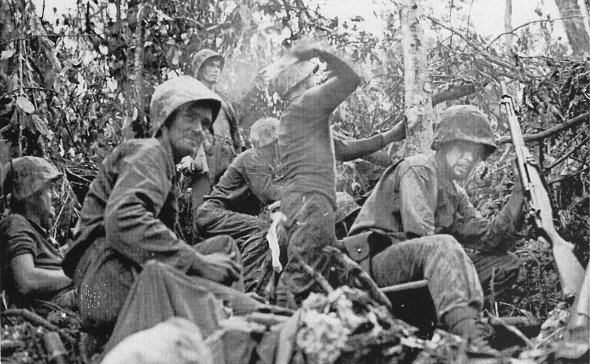
Department of Defense Photo (USMC) 95375
Marines using rifle grenades, hand grenades, and “Molotov cocktails” battle Japanese holed up in caves in northern Peleliu. Note the torch in the foreground which was used to ignite the “cocktails” and the flaming bottle of gas ready to be thrown.
What was not yet appreciated was that the Marines were confronting the most comprehensive set of caves and tunnels on Peleliu. They were trying to invade the home (and defensive position) of a long-established naval construction unit most of whose members were better miners than infantrymen. As dark fell, the 2d Battalion cut itself loose from the units to its south, and formed a small battalion beachhead for the night.
During the night of 27 September, one of the weapons from the 8th 155mm Gun Battalion was moved into position in 2/5’s sector about 180 yards from Amiangal Ridge.
Department of Defense Photo (USMC) 95941
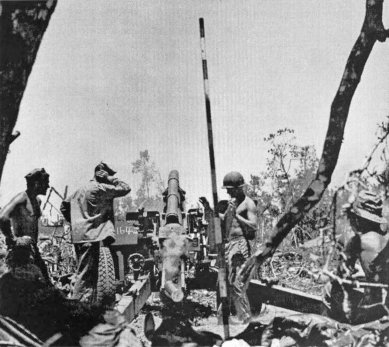
The next morning, as the 2d Battalion, 5th Marines, tried to move along the route leading to the northern nose of Amiangal Ridge, it ran into a wide and deep antitank ditch which denied the attacking infantry the close tank support they had so successfully used earlier. At this point, the 5th Marines command31 asked, again, for point-blank artillery.
This time, division headquarters responded favorably. During the night of 27 September Major George V. Hanna’s 8th 155mm Gun Battalion moved one of its pieces into position in 2/5’s sector. The gun was about 180 yards from the face of Amiangal Ridge. The sight of that threat at dawn elicited enemy machine-gun fire which inflicted some casualties upon the artillerymen. This fire was quickly suppressed by Marine infantry fire, and then by the 155mm gun itself. Throughout the morning, the heavy 155mm fire played across the face of Amiangal Ridge, destroying or closing all identified caves on the west face, except for one. That latter was a tunnel mouth, down at ground level and on the northwestern base of the hill. It was too close to friendly lines to permit the gun to take it under fire. But by then, tanks had neutralized the tunnel mouth, and a tank bulldozer filled in a portion of the antitank ditch. This allowed 2/5’s tank-infantry teams to close on the tunnel mouth, to blast and bulldoze it closed, and to press on around the northern nose of Amiangal. Simultaneously, Marines swept over the slopes above the tunnel and “seized” the crest of the small mountain.
The term seizure is qualified, for although 2/5 held the outside of the hill, the stubborn Japanese defenders still held the inside. A maze of interconnected tunnels extended throughout the length and breadth of the Amiangal Ridge. From time to time the Japanese inside the mountain would blast open a previously closed cave or tunnel mouth, and sortie to challenge the Marines. Notwithstanding their surprise effect, these counterattacks provided a rare and welcome opportunity for the Marines actually to see their enemy in daylight. Such tactics were inconsistent with the general Japanese strategy for Peleliu, and somewhat shortened the fight for the northern end of the island.
As that fighting progressed, the 5th Marines assembled its 3d Battalion, supporting tanks, amphibian tractors, and the entire panoply of naval gunfire, and air support to launch a shore-to-shore operation to seize Ngesebus and Kongauru, 600 yards north of Peleliu, on 28 September.
There followed an operation which was “made to look easy” but which in fact involved a single, reinforced (but depleted) battalion against some 500 prepared and entrenched Japanese infantry. For some 35 hours, the battalion conducted the most cost-effective single battalion operation of the entire Peleliu campaign.

Much of the credit for such effectiveness was due to supporting aviation. VMF-114, under Major Robert F. “Cowboy” Stout, had landed on Peleliu’s air strip just three days prior to this landing, and immediately undertook its primary service mission: supporting Marine ground operations. The Ngesebus landing was the first in the Pacific War for which the entire air support of a33 landing was provided by Marine aviation. As the LVTs entered the water from Peleliu’s shore, the naval gunfire prematurely lifted to the alarm of the assault troops. Stout’s pilots immediately recognized the situation, resumed their strafing of Ngesebus until the LVTs were within 30 yards of the beach. They flew so low that the watching Marines “expected some of them to shoot each other down by their ricochets.” This action so kept the Japanese defenders down that the Marines in the leading waves were upon them before they recovered from the shock of the strafing planes.
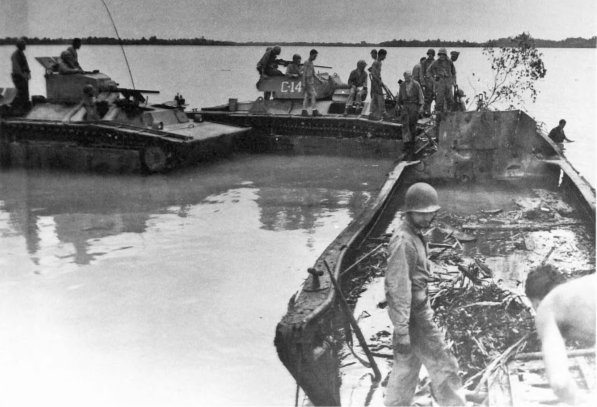
Department of Defense Photo (USMC) 95931
The crews of amphibian tractors board a severely damaged Japanese landing craft which was intercepted by U.S. naval patrols when it carried troops attempting to infiltrate northern Peleliu and reinforce Ngesebus Island off northwest Peleliu.
A western-looking aerial view of the northern end of Peleliu showing Peleliu village and the Amiangal Mountain. Ngesebus Island is in the upper right. Veterans of Peleliu will be amazed to note how fully the island has been recaptured by vegetation.
Caption and Photo by Phillip D. Orr
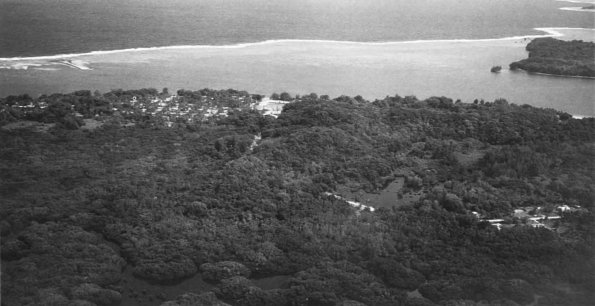
The 3d Battalion got ashore with no casualties. Thus enabled to knock out all the Japanese in beach defenses immediately, it turned its attention to the cave positions in the ridges and blockhouses. The ridges here, as with those on northern Peleliu, stood individually, not as part of complex ridge systems. This denied their defenders opportunities for a mutual defense between cave positions. The attacking companies of 3/5 could use supporting tanks and concentrate all fire means upon each defensive system, without being taken under fire from their flanks and rear. By nightfall on 28 September, 3/5 had overrun most of the opposition. On 29 September, there was a day of mopping up before Ngesebus was declared secure at 1500. As planned, the island was turned over to 2/321, and 3/5 was moved to division reserve in the Ngardololok area.
Seizure of Ngesebus by one depleted infantry battalion gave a dramatic illustration of an enduring principle of war: the effective concentration of means. To support that battalion, General Rupertus concentrated the bulk of all his available firepower: a battleship; two cruisers; most of the divisional and corps artillery; virtually all of the division’s remaining armor; armored amphibian tractors; all troop-carrying amphibian tractors; and all Marine aviation on Peleliu.
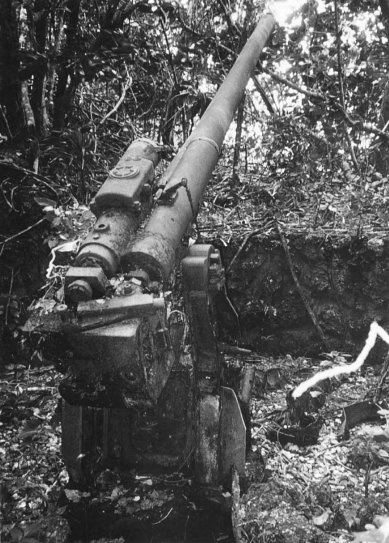
Caption and photo by Phillip D. Orr
Possibly one of the best preserved specimens of its kind in the Pacific this Model 10 120mm dual-purpose antiaircraft and coastal defense gun is on the western shore of Ngesebus. The gun rests on its skid plate and was sited in a natural position.
Such concentrated support enabled the heavily depleted 3d Battalion, 5th Marines, to quickly seize Ngesebus, destroying 463 of Colonel Nakagawa’s battle-hardened and well-emplaced warriors in 36 hours, at a cost of 48 American casualties.
Other maneuver elements on Peleliu also were attacking during those 36 hours, but at an intensity adjusted to the limited support consequent upon General Rupertus’ all-out support of the day’s primary objective.
As 3/5 was clearing Ngesebus, the rest of the 5th Marines was fighting the Japanese still in northeast Peleliu. After capturing Akarakoro Point beyond Amiangal Mountain, 2/5 turned south. It swept through the defenses east of that mountain with demolitions and flamethrowers, then moved south toward Radar Hill, the eastern stronghold of Hill Row. That feature was under attack from the south and west by 1/5. After two days, the two battalions were in command of the scene, at least on the34 topside of the hills. Inside there still remained stubborn Japanese defenders who continued to resist the contest for Radar Hill, as did the defenders within Amiangal Mountain’s extensive tunnels. All could be silenced when the cave or tunnel mouths were blasted closed.
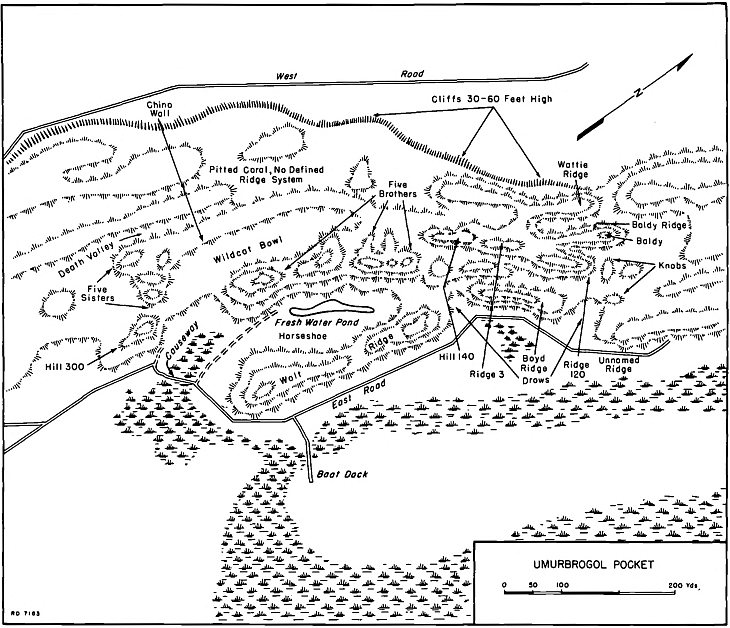
As these operations were in progress, the 321st at the north end of Umurbrogol completed seizing Hills 100 and Hill B, then cleared out the ridge (Kamilianlul Mountain) and road north from there to the area of 5th Marines operations. On 30 September the 321st relieved the 1st and 2d Battalions of the 5th Marines in northern Peleliu. That regiment reassembled in the Ngardololok area, before it became once more necessary to commit it to the Umurbrogol Pocket.
The Umurbrogol Pocket:
Peleliu’s Character Distilled
In a very real sense, the Umurbrogol Pocket typified the worst features of the post D-Day campaign for Peleliu. It provided the scene of some of Peleliu’s worst and most costly fighting, and of some of the campaign’s best and worst tactical judgments. Its terrain was the most difficult and challenging on the island. Prelanding planning did not perceive the Pocket for what it was, a complex cave and ridge fortress suitable to a fanatic and suicidal defense. Plans for the seizure of the area treated the Pocket’s complex terrain as oversimplified, time-phased linear objectives to be seized concurrently with the flat terrain abutting it to the east and west.
The southern slopes (generally called Bloody Nose) dominated the landing beaches and airfield, over which the Pocket had to be approached. After those heights were conquered by the heroic and costly assaults of Puller’s 1st Marines (with Berger’s 2/7 attached), and after the division had set in artillery which was controlled by aerial observers overhead, the situation changed radically. The Pocket’s defenders thereafter retained only the capability to harass and delay the Americans, to annoy them with intermittent attacks by fire and with night-time raids. But35 after D plus 4, Umurbrogol’s defenders could no longer seriously threaten the division’s mission.
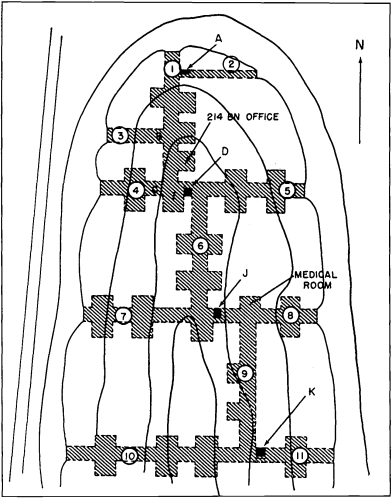
Nevertheless, after the critical enemy observation sites were seized, General Rupertus kept urging “momentum,” as though the seizure of the Pocket were as urgent as had been seizure of the commanding heights guarding it from the south. The stubborn character of the terrain, and its determined defenders, became entwined with the determined character of the general commanding the 1st Marine Division. This admixture was sorted out only by time and by the reluctant intercession of General Geiger. Most of the offensive effort into the Pocket between 21 and 29 September was directed from south to north, into the mouths or up onto the ridges of the twin box canyons which defined the Pocket. Infantry, supported by tanks, air, and flame-throwing LVTs could penetrate the low ground, but generally then found themselves surrounded on three sides. Japanese positions inside the ridges of the canyons, hidden from observation and protected in their caves, were quite capable of making the “captured” low ground untenable. Other attacks, aimed at seizing the heights of the eastern ridges, while initially successful, in that small infantry units could scramble up onto the bare ridge tops, thereafter came under fire from facing parallel ridges and caves. They were subject to strong night counterattacks from Japanese who left their caves under cover of darkness.
During 20 September, D plus 5, the 7th Marines had relieved the 1st Marines along the south and southwest fronts of the Pocket, and on the 21st the 3d and 1st Battalions resumed the attack into the Pocket, from southwest and south. These attacks achieved limited initial successes behind heavy fire support and smoke, but succeeded only in advancing to positions which grew untenable after the supporting fire and smoke was lifted. Assault troops had to be withdrawn under renewed fire support to approximately their jump-off positions. There was little to show for the day’s valiant efforts.
Attacks the next day (22 September) against the west shoulder of the Pocket, from the West Road, up the western box canyon (Wildcat Bowl) and toward Higashiyama (Hill 140), all liberally supported with firepower, again produced early advances, most of which had to be surrendered at day’s end, as all three attacking groups came under increasing fire from the Japanese hidden in mutually supporting cave positions. The 7th Marines had, unbeknown to it, reached within about 100 yards of Colonel Nakagawa’s final command cave position. However, many supporting ridges, and hilltops, would have to be reduced before a direct attack upon that cave could have any hope of success.
The fight for Umurbrogol Pocket had devolved into a siege situation, to be reduced only by siege tactics. But the 1st Marine Division’s commander continued to cling to his belief that there would be a “break-thru” against the enemy’s opposition. He insisted that continued battalion and regimental assaults would bring victory “very shortly.”
When the 321st’s probes eastward36 near the northern end of the Pocket brought them within grasp of sealing off that Pocket from the north, they deployed two battalions (2d and 3d) facing eastward to complete the encirclement.
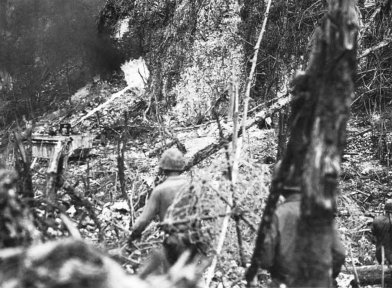
Department of Defense Photo (USMC) 98260
Many of the participants in the battle with a literary turn of mind best compared the ridge areas of Peleliu with the description of Dante’s “Inferno.” Here a flame thrower-mounted amphibian tractor spews its deadly stream of napalm into a cave.
This attack against Hill B, the stopper at the northern end of the Pocket absorbed the 321st Infantry’s full attention through 26 September, as the 5th Marines was fighting in northern Peleliu. The 7th Marines continued pressuring the Pocket from the south, and guarding it on the west. With the 321st victory on the 26th, that unit’s mission was expanded to press into the Pocket from the north. This it did, while simultaneously clearing out the sporadically defended Kamilianlul Ridge to its north. Its attack south from Hill B and adjacent ridges made very limited progress, but permitted some consolidation of the American hold along the north side of the Pocket, now 400 yards wide in that zone. On 29 September, the 7th Marines was ordered to relieve the Army unit in that northern sector.
To relieve 2/7 and 3/7 of their now largely static guard positions along the west and southwest sectors of the Pocket, the division stripped hundreds of non-infantry from combat support units (artillery, engineer, pioneer), and formed them into two composite “infantillery” units. Under 11th Marines’ Lieutenant Colonel Richard B. Evans and 5th Marines’ Major Harold T. A. Richmond, they were assigned to maintain the static hold in the sectors earlier held by 2/7 and 3/7. They faced the karst plateau between the West Road and the Pocket.
The 7th Marines’ flexibility restored by this relief, its 1st and 3d Battalions relieved the 321st units on 29 September, along the north edge of the Pocket. Then on the 30th, they pushed south, securing improved control of Boyd Ridge and its southern extension, variously called Hill 100, Pope’s Ridge, or Walt Ridge. The latter dominated the East Road, but Japanese defenders remained in caves on the west side. The 7th Marines’ partial hold on Pope Ridge gave limited control of East Road, and thereby stabilized the east side of the Pocket. But the U.S. hold over the area needed improvement.
On 3 October, reinforced by the attached 3/5 (back from Ngesebus), the 7th Regiment organized a four-battalion attack. The plan called for 1/7 and 3/7 to attack from the north, against Boyd Ridge and the smaller ridges to its west, while 2/7 would attack Pope (Walt) Ridge from the south. The attached 3/5 was ordered to make a diversionary attack from the south into the Horseshoe canyon and its guardian Five Sisters on its west. This regimental attack against the Pocket committed four infantry “battalions,” all now closer to company than battalion strength, against the heights near the southern end of the Pocket (Five Sisters), and the ridges at the eastern shoulder of the Pocket (Pope and Boyd Ridges). After heavy casualties, the attack succeeded, but the Five Sisters (four of which 3/5 scaled) were untenable, and had to be abandoned after their seizure.
The next day, 4 October, the 7th Marines with 3/5 still attached made one more general attack—in the south, again to seize, then give up, positions on the Five Sisters; in the north, to try to advance and consolidate the positions there earlier seized.
In that 4 October action, the 3d Battalion, 7th Marines’ push led to an unexpectedly rapid advance which it pressed to get up onto Hill 120. It was hoped that this would provide a good jump-off for the next day’s operation against the next ridge to the west. However, Hill 120, as with so many others in the Umurbrogol, was then under enemy crossfire which made it completely untenable. The attacking company was withdrawn with heavy casualties. Among these casualties was Captain James V. “Jamo” Shanley, commanding Company L. His company was attacking Ridge/Hill 120 when several of his men fell, wounded. Shanley dashed forward under heavy fire, rescued two of the men and brought them to safety behind a tank. He then rushed back to help a third,37 when a mortar round landed immediately behind him, mortally wounding him. His executive officer, Lieutenant Harold J. Collins ran out to rescue him, only to fall by his side instantly killed by a Japanese antitank round.
For his heroism Captain Shanley was awarded a Gold Star (second) for the Navy Cross he had earned at Cape Gloucester, New Britain. There, his company was in the lead in seizing Hill 660, a key terrain feature in the Borgen Bay area.
The 7th Marines had now been in the terrible Umurbrogol struggle for two weeks. General Rupertus decided to relieve it, a course General Geiger also suggested. Still determined to secure the Pocket with Marines, General Rupertus turned to his only remaining Marine regiment, the 5th.
Colonel Harris brought two firm concepts to this final effort for his 5th Marines. First, the attack would be from the north, an approach which offered the greatest opportunity to chip off one terrain compartment or one ridge at a time. His 1st Battalion positions along the east side of the Pocket would be held statically, perhaps incrementally adjusted or improved. No attacks would be launched from the south, where the 3d Battalion was positioned in reserve.
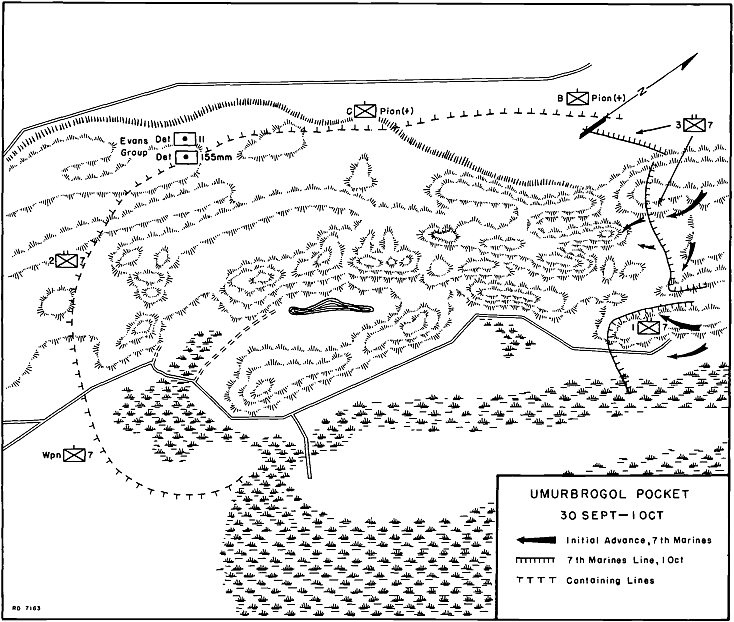
UMURBROGOL POCKET
30 SEPT–1 OCT
Colonel Harris’ aerial reconnaissance during the first week on Peleliu had convinced him that siege tactics would be required to clear the multitude of mutually defended positions within Umurbrogol. As he had earlier expressed himself in the presence of the corps and division commanders visiting his regimental CP, Harris continued with his policy to “be lavish with ammunition and stingy with ... men’s lives.” He was in a strong command position to prepare support thoroughly before ordering advances.
The 2d Battalion, 5th Marines, relieved 3d Battalion, 7th Marines in position on 5 October, but did nothing but reconnoiter positions where38 heavier firepower could come into play. Engineer dozers were brought up to prepare paths into the north ends of the box canyons, along which LVT flamethrowers and tanks could later operate. A light artillery battery was emplaced along the West Road to fire point-blank into the west-facing cliffs at the north end of the Pocket, as were weapons carriers and tanks later. Troublesome sections of certain cliffs were literally demolished by direct fire, and the rubble dozed into a ramp for tanks to climb toward better firing positions. Light mortars were used extensively to strip vegetation from areas in which firing caves were suspected, and planes loaded with napalm-filled belly tanks were used to bomb suspected targets just south of the key Hill 140, which 2/5 had selected as its key objective.
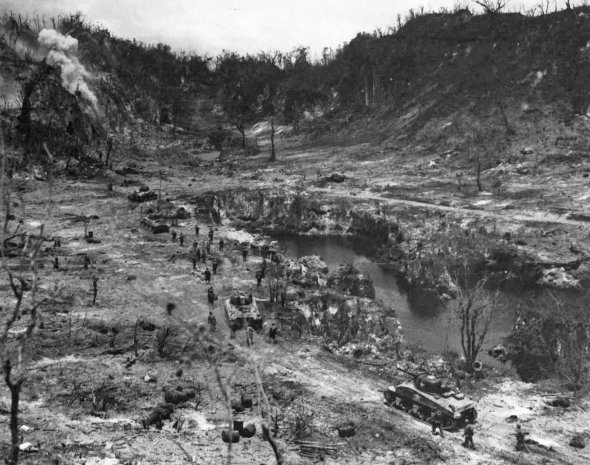
Department of Defense Photo (USMC) 97433
Marine riflemen accompanied by tanks push forward to the inner recesses of Horseshoe Ridge in an effort to cut off the enemy water supply and rid it of Japanese troops once and for all. The going got no easier as the Americans pushed forward.
Marines who fought on Pope Ridge would not recognize it in this photograph of the southern end of the ridge looking north showing how the vegetation took over.
Caption and photo by Phillip D. Orr
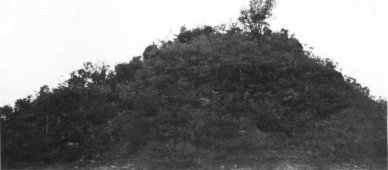
As 2/5 picked off successive firing positions in the north, 3/5 on 7 October sent a tank sortie into the Horseshoe. This time, the mission was not to seize and hold, but to destroy by fire all identifiable targets on the faces of the Five Sisters, and on39 the western (lower) face of Hill 100 (Pope Ridge). When all ammunition was expended, the tanks withdrew to rearm then returned, accompanied by LVT flame-throwing tanks and guarded by small infantry fire-teams. Considerably more destruction was effected, a large number of Japanese were killed in caves, and many of the Japanese heavy weapons in those caves were silenced. Previous to this time, some single artillery pieces firing from within the Horseshoe had occasionally harassed the airfield. No such nuisance attacks occurred after the 7 October tank sorties.
For the next six days, the 5th Marines headquarters afforded all available support to small, incremental advances by 2/5 from the north. Light mortars were repeatedly used to clear all vegetation from small objectives and routes of advance. Both tanks and artillery were used at point-blank ranges to fire into all suspected caves or rough coral areas. Aerial bombardment with napalm was used to clear vegetation and, hopefully, drive some defenders further back into their caves. All advances were very limited, aimed simply at seizing new firing positions. Advances were made by squads or small platoons.
The last position seized, Hill 140, just north of the Five Brothers, afforded a firing site to which a 75mm pack howitzer was wrestled in disassembled mode, reassembled, sandbagged, and then effectively fired from its then-commanding position. It could fire into the mouth of a very large cave at the base of the next ridge, from which serious fire had been received for days.
Sandbagging this piece into position posed special problems, since the only available loose sand or dirt had to be carried from the beach, or occasional debris slides. Nevertheless, the use of sandbags in forward infantry positions began to be used increasingly, and the technique was later improved and widely used when 81st Infantry Division soldiers took over further reduction of the Pocket.
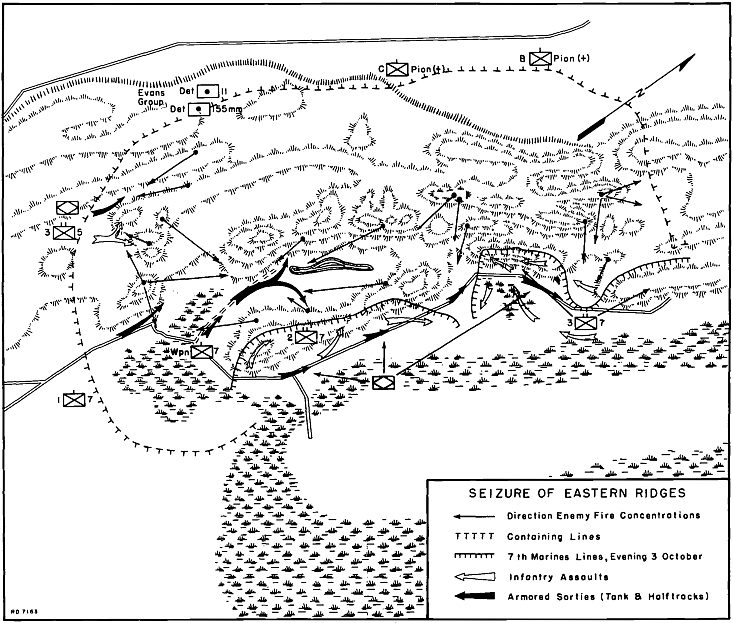
By this mode of careful advance,40 a number of small knobs and ridges at the head of the two murderous box canyons were seized. Direct fire could be laid into the west face of Walt and Boyd Ridges, whose tops were occupied by 1/5, but those cave-filled western slopes were protected by other caves on the opposite, parallel ridge known as Five Brothers.

Department of Defense Photo (USMC) 97878
Maj Gordon D. Gayle, commander of 2d Battalion, 5th Marines, outlines in the sand proposed enemy targets in the north for LtCol Joslyn R. Bailey, Marine Aircraft Group 11. Looking on are Col Harold D. Harris, 5th Marines commander, center, and LtCol Lewis W. Walt, behind Gayle, 5th Marines executive officer.
A week of such siege-like activity pushed the northern boundary of the Pocket another 500 yards south. On 12 October, the 3d Battalion, 5th Marines was called in to relieve 2d Battalion, 5th Marines. The relief was seriously marred, primarily because the forward positions being relieved were so close to the opposing enemy. The incoming troops, including a company commander, were picked off by snipers during this exchange, and a small group of enemy reoccupied a position earlier subdued by frequent interdiction fires. Despite these losses and interruptions, the relief was completed on schedule, and on 13 October, 3/5 continued the slow and deliberate wedging forward.
Directly south of Hill 140, there seemed no feasible axis for advance, so 3/5’s axis was shifted southwest, approximately paralleling the West Road, and into the coral badlands in front of the containing lines manned by the composite groups guarding West Road. While the composite groups held in place, 3/5 operated across their front, north to south. By this means the coral badlands were cleared out for an average (east-west) depth of 75–150 yards, along some 500 yards of the north-south front. This terrain, earlier judged unsuitable for any but the costliest and most difficult advance, was now traversed with the aid of preparatory fire-scouring by napalm bombs. Major “Cowboy” Stout’s VMF-114 pilots’ bombs fell breathtakingly close to both the advancing 3/5 front and to the stationary composite units holding just east of West Road.
A similar effort was then launched from the south by what was left of Lieutenant Colonel John Gormley’s 1/7. Together, these two advances seized and emptied about one-half of the depth of the coral badlands, between West road and the China Wall. This clearing action allowed the composite “infantillery” unit to advance its lines eastward and then hold, as far as the infantry had cleared, toward the back of China Wall.
Overall, the actions of the 5th and 7th Marines in October had reduced the Pocket to an oval some 800 yards, north to south, and 400–500 yards, east to west. According to Colonel Nakagawa’s contemporaneous radio report back to Koror, he still had some 700 defenders within the Pocket, of which only 80 percent were effective. In early October, some wag had suggested that the Pocket situation be clarified by enclosing it with barbed wire and designating it as a prisoner of war enclosure. Spoken in bitter jest, the concept did recognize that the Pocket no longer counted in the strategic balance, nor in completing the effective seizure of Peleliu.
But it still weighed significantly in the mind of Major General Rupertus, who wanted to subdue the Pocket before turning over to Major General Mueller the 81st Division’s previously specified mopping-up task. In point of fact, Rupertus’ successful seizure of Ngesebus and northern Peleliu had terminated the enemy’s capability to reinforce the now-isolated Japanese on Peleliu. Creation of that tactical situation had effectively secured Peleliu.
Without pressing for a declaration that Peleliu had been effectively secured, which would have formalized the completion of the 1st Marine Division’s mission, General Geiger had for some days suggested that in continuing his attacks into the Pocket, Rupertus relieve first the 5th, then the 7th Marines with his largest and freshest infantry regiment, the 321st RCT, still attached to 1st Marine Division. To all such suggestions, General Rupertus replied that his Marines would “very shortly” subdue the Pocket.
Two events now overtook General41 Rupertus’ confidence. First, the 81st Division was made whole by the return of its 323d RCT, fresh from its critically important seizure of Ulithi. Second, the perception that Peleliu was effectively secured was validated by a message which so stated from Admiral Chester W. Nimitz, Commander in Chief, Pacific Fleet/Commander in Chief, Pacific Ocean Areas. Major General Geiger was directed to turn over command to Major General Mueller, whose 81st Division was now directed to relieve the 1st Marine Division, to mop up, and to garrison Peleliu, as long planned. Rear Admiral George E. Fort, Rear Admiral Theodore S. Wilkinson’s successor as commander of operations in the Palaus, was directed to turn over that responsibility to Vice Admiral John H. Hoover, a sub-area commander. When relieved by the 81st Division, the 1st Marine Division would embark for return to Pavuvu.
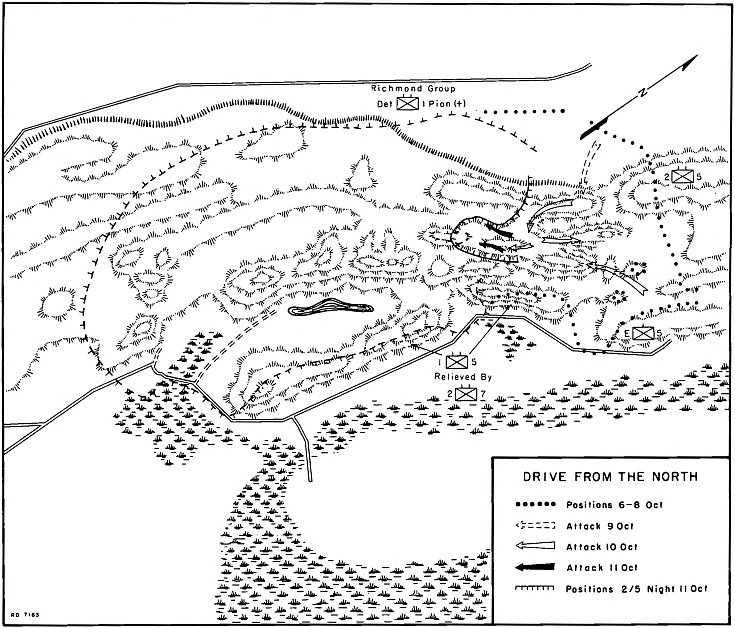
During the movement and turnover, tactical operations ashore necessarily remained under 1st Marine Division control until the 81st Division could move its command post from Angaur. General Mueller established his CP near Peleliu’s Purple Beach on 20 October. The Wildcat Division thereupon acquired “custody” of the Pocket, and responsibility for final reduction of its determined, able, battered defenders.
Meanwhile, the relief of the 5th Marines by the 321st RCT took place on 15 and 16 October. While that relief was in progress, Lieutenant Colonel Gormley’s 1/7 was still engaged in the earlier-described coral badlands action, to make possible the eastward movement of the containing lines protecting West Road. The relief of 1/7 was accordingly delayed until the next day. On 17 October, a full-strength Company B, 1/323, newly arrived from Ulithi, relieved Gormley’s surviving battalion, approximately man for man.
Post-assault Operations in the Palaus
When on 20 October Major General Mueller became responsible for mopping up on Peleliu, he addressed42 the tactical problem as a siege situation, and directed his troops to proceed accordingly. Over a period of nearly six weeks, his two regiments, the 322d and 323d Infantry, plus 2/321, did just that. They used sandbags as an assault device, carrying sand up from the beaches and inching the filled sandbags forward to press ever nearer to positions from which to attack by fire the Japanese caves and dug-in strong points. They made liberal use of tanks and flamethrowers, even improving upon the vehicle-mounted flamethrower. They thrust a gasoline pipeline forward from a roadbound gasoline truck, thereby enabling them, with booster pumps, to throw napalm hundreds of feet ahead into Japanese defensive areas. Noting the effectiveness of the 75mm pack howitzer which the Marines had wrestled up to Hill 140, they sought and found other sites to which they moved pack howitzers, and from which they fired point-blank into defending caves. To support their growing need for sandbags on ridge-top “foxholes,” their engineers strung highlines to transport sand (and ammo and rations) up to such peaks and ridgetops.
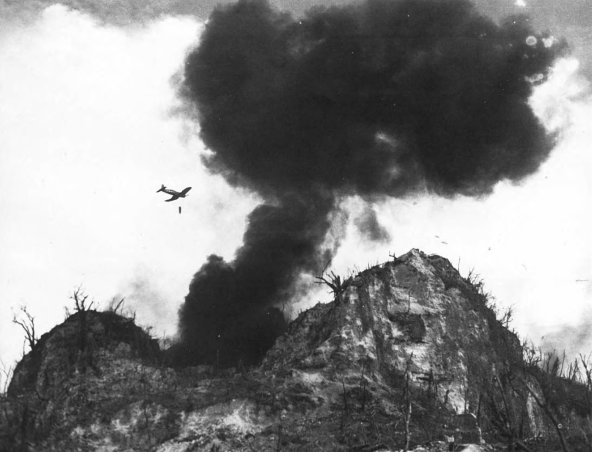
Department of Defense Photo (USMC) 98401
As a result of Maj Gayle’s targetting of enemy positions in the Umurbrogol, napalm-laden Marine Corsairs lifted from Peleliu’s airfield, and returned to the field to be rearmed, in perhaps the shortest wheels-down bombing run of the Pacific War.
Notwithstanding these deliberate siege tactics, the 81st troops still faced death and maiming as they ground down the bitter and stubborn Japanese defenses. The siege of the Umurbrogol Pocket consumed the full efforts of 81st Division’s 322d RCT and 323d RCT, as well as 2/321, until 27 November 1944 (D plus 73).
This prolonged siege operation was carried on within 25 miles of a much larger force of some 25,000 Japanese soldiers in the northern Palaus. Minor infiltrations aside, those Japanese were isolated by U.S. Navy patrols, and by regular bombing from Marine Aircraft Group 11, operating from Peleliu.
Difficult and costly as the American advances were, the Japanese defenders in their underground positions had a similarly demanding and even more discouraging situation. Water was low. Sanitation was crude to nonexistent. Rations were short, and ammunition was even scarcer. As time wore on, some of the Japanese, when afforded opportunity, chose to leave their defenses and undertake futile, usually suicidal night attacks. A very few succeeded43 in being captured.
Toward late November, even Major General Murai apparently came to this point of view. Still not in command, he nevertheless proposed, in a radio message to Lieutenant General Inoue on Koror, a banzai finale for their prolonged defense. But General Inoue turned down the proposal. By this time, Nakagawa’s only exterior communications were by radio to Koror. As he had anticipated, all local wire communications had been destroyed. He had issued mission orders to carry his units through the final phase of defense.
As the tanks and infantry carefully pressed their relentless advances, the 81st Division’s engineers pressed forward and improved the roads and ramps leading into or toward the heart of the Japanese final position. This facilitated the tank and flamethrower attacks to systematically reduce each cave and position as the infantry pushed its sandbag “foxholes” forward.
On 24 November, Colonel Nakagawa sent his final message to his superior on Koror. He advised that he had burned the colors of the 2d Infantry Regiment. He said that the final 56 men had been split into 17 infiltration parties, to slip through the American positions and to “attack the enemy everywhere.” During the night of 24–25 November, 25 Japanese, including two officers, were killed. Another soldier was captured the following morning. His interrogation, together with postwar records and interviews, led to his conclusion that Colonel Nakagawa and Major General Murai died in the CP, in ritual suicide.

The final two-day advance of the 81st Division’s soldiers was truly and literally a mopping-up operation. It was carefully conducted to search out any holed-up opposition. By midday on 27 November, the north-moving units, guarded on the east by other Army units, met face-to-face with the battalion moving south, near the Japanese CP later located. The 323d’s commander, Colonel Arthur44 P. Watson, reported to General Mueller that the operation was over.
Not quite. Marine air on Peleliu continued to attack the Japanese positions in Koror and Babelthuap, joining the patrolling Navy units in destroying or bottling up any remaining Japanese forces in the northern Palaus. A late casualty in that action was the indomitable Major Robert F. “Cowboy” Stout, whose VMF-114 had delivered so much effective air support to the ground combat on Peleliu.

The stubborn determination of the Japanese to carry out their emperor’s war aims was starkly symbolized by the last 33 prisoners captured on Peleliu. In March 1947, a small Marine guard attached to a small naval garrison on the island encountered unmistakable signs of a Japanese military presence in a cave in the Umurbrogol. Patrolling and ambushes produced a straggler, a Japanese seaman who told of 33 remaining Japanese under the military command of Lieutenant Tadamichi Yamaguchi. Although the straggler reported some dissension within the ranks of that varied group, it seemed that a final banzai attack was under consideration.
The Navy garrison commander moved all Navy personnel, and some 35 dependents, to a secure area and sent to Guam for reinforcements and a Japanese war crimes witness, Rear Admiral Michio Sumikawa. The admiral flew in and travelled by jeep along the roads near the suspected cave positions. Through a loudspeaker he recited the then-existing situation. No response. Finally, the Japanese seaman who had originally surrendered went back to the cave armed with letters from Japanese families45 and former officers from the Palaus, advising the hold-outs of the end of the war. On 21 April 1947, the holdouts formally surrendered. Lieutenant Yamaguchi led 26 soldiers to a position in front of 80 battle-dressed Marines. He bowed and handed his sword to the American naval commander on the scene.
Was the Seizure of Peleliu Necessary? Costs vs. Benefits
What advantages to the United States’ war effort grew from the conquest of Peleliu? It assured absolute domination of all of the Palaus, thereby adding, marginally, to the security of MacArthur’s right flank as he continued westward, then northward from New Guinea into his Philippines campaign. Within the Palaus group, it destroyed facilities which survived Admiral Marc A. Mitscher’s devastating strike of March 1944. It insured total denial of support to the enemy from Koror’s submarine basing facilities, incrementally decreasing the already waning Japanese submarine capability east of the Philippines. The United States position on Peleliu completed the neutralization of the some 25,000 Japanese troops in northern Palau. The landing on Peleliu did not contribute to the Regimental Landing Team (RLT) 323 unopposed seizure of Ulithi. Admiral William F. Halsey had earlier believed that his forces could seize Ulithi without first seizing Peleliu.
The most visible benefit of a subdued Peleliu lay in its use as a link in the flight path and line of communications from Hawaii, and from the Marianas, to the Philippines. The holding was a convenience, but not a necessity.
With the senior officers present, division chaplains dedicate a new cemetery created at Orange Beach 2. The 1st Division commander, MajGen Rupertus, with a cane, is near the center and to his right is Col Puller (1st Marines). Grouped on the extreme right are: BGen Smith, assistant division commander; Col Harrison (11th Marines), and Col Harris (5th Marines). Not present at this time was the 7th Marines’ commander, Col Hanneken, whose regiment was still engaged with the enemy.
Department of Defense Photo (USMC) 96989
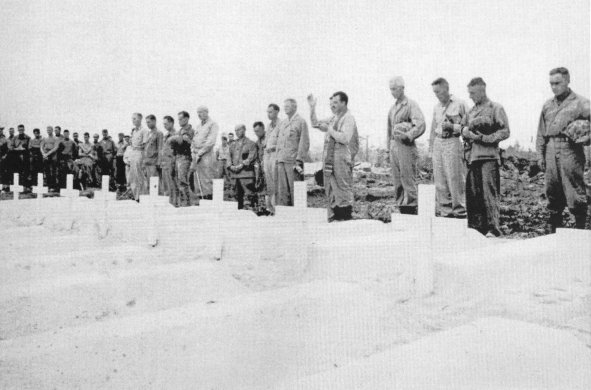
Such judgment could be disputed, however, by the survivors of the Indianapolis’ 29 July 1945 sinking. Having delivered atomic bomb parts to Tinian shortly before, the ship was headed for the Philippines, when it was suddenly torpedoed at night. The ship went down in 12 minutes, and no report of the contact or the sinking was received. The fourth day after the sinking, its 316 survivors (from a crew of 1,196) were sighted by a Navy patrol bomber working out of Peleliu. The sighting led directly to their rescue, and most certainly would not have occurred, but for American occupation of Peleliu.
46 What did the seizure of Peleliu cost? Marine casualties numbered 6,526, including Navy corpsmen and doctors, of whom 1,252 were killed. The 81st Division totalled 3,089 casualties, of whom 404 were killed in action. Total U.S. troop casualties was 9,615 for Peleliu, Angaur and Ngesebus, with 1,656 dead.
By inflicting that many casualties, the Japanese were successful in implementing their longstanding “delay and bleed” strategy. The actions cost them an estimated 10,900 casualties, all but a tiny fraction killed. Just 202 prisoners of war were captured, only 19 of whom were Japanese military (seven Army, 12 Navy). The others were laborers, largely Korean. Among the Japanese military defenders, less than two per thousand were captured.
The costs at Peleliu held warnings aplenty for the remaining Allied operations to be conducted across the Pacific to Japan. Even with total local air and naval superiority, with lavish naval gunfire and bombs, with the dreaded napalm weaponry, and with a 4:1 troop superiority, the seizure of Peleliu consumed one American casualty and 1,589 rounds of heavy and light troop ammunition for each single Japanese defender killed or driven from his prepared position. A few months later, the attacks on Iwo Jima and Okinawa would confirm this grim calculus of war against determined Japanese defenders, ably led, in prepared defenses.
The question of whether the Peleliu operation was necessary remains moot, even today, some 52 years after the 1 September 1944 landing. The heroism and exemplary conduct of the 1st Marine Division, its Marines and Navy corpsmen, and the soldiers of the 81st Infantry Division on that miserable island is written in the record. But there is an enduring question of whether the capture of Peleliu was essential, especially in view of Admiral William F. Halsey’s recommendation through Admiral Nimitz to the Joint Chiefs of Staff on 13 September 1944, two days before D-Day, that the landing be cancelled. By that time, it was too late. And Peleliu was added to the long list of battles in which Marines fought and suffered, and prevailed.
[Sidebar (page 46):]
Tom Lea’s Paintings

Tom Lea, the artist of the paintings which illustrate this pamphlet, wrote of his experiences on Peleliu in Battle Stations, published in 1988 by Still Point Press in Dallas. Some of the sketches from this book were reproduced with commentary in Volume 14, Number 2 of Discovery, a journal published by the University of Texas at Austin. In this issue, James Jones, author of From Here to Eternity, wrote: “Lea was one of the artists put in the field by Life.... Various of his works appeared in the magazine, and up until the time he went into Peleliu, most of them could be pretty well classified as excellently done but high-grade propaganda. There was very little American blood, very little tension, very little horror. Mostly, it was what could be called the Bravo America! and This is Your Boy type of war art. His almost photographic style easily lent itself to that type of work....
“But something apparently happened to Lea after going into Peleliu. The pictures painted out of his Peleliu experience show a new approach. There is the tension of terror in the bodies here, the distorted facial expressions of the men under fire show it, too....
“One of the most famous, of course, is the Two-Thousand-Yard Stare portrait of a young marine who has had all, or more than, he can take. The staring eyes, the slack lips, the sleepwalker’s stance. I’ve seen men with that look on their faces. I’ve had it on my own face. It feels stiff, and the muscles don’t want to work right when you try to smile, or show expression, or talk. Mercifully, you’re out of it for a while; unmercifully, down in the center of that numbness, though, you know you will have to come back eventually.”
Reprinted by permission of Discovery, the University of Texas at Austin. Tom Lea’s artwork in this pamphlet is reproduced with the permission of the artist. The captions under each of the Lea paintings are the artist’s own words.
Benis M. Frank

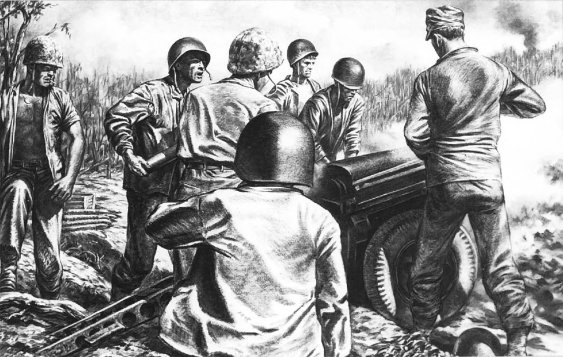
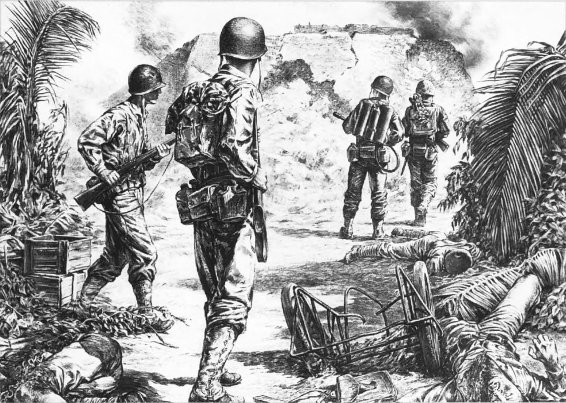
[Sidebar (page 48):]
For Extraordinary Heroism
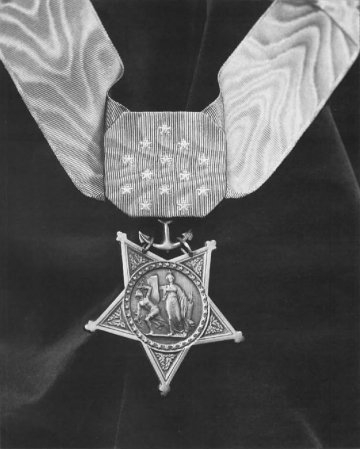
The Secretary of the Navy awarded the Presidential Unit Citation to the 1st Marine Division, and its reinforcing organizations, for “extraordinary heroism in action against enemy Japanese forces at Peleliu and Ngesebus from September 15 to 29, 1944.” In addition, Marine Aircraft Group 11 and the 3d 155mm Howitzer Battalion were awarded the Navy Unit Commendation. On an individual basis, 69 participants in the battle for Peleliu were decorated with the Navy Cross, the second seniormost combat award in the Naval service.
The nation’s highest award, the Medal of Honor, was presented to eight Marines in the fight for Peleliu; five were decorated posthumously, as indicated by (*): *Corporal Lewis K. Bausell, USMC, 1/5; Private First Class Arthur J. Jackson, USMC, 3/7; *Private First Class Richard E. Kraus, USMCR, 8th Amphibian Tractor Battalion; *Private First Class John D. New, USMC, 2/7; *Private First Class Wesley Phelps, USMCR, 3/7; Captain Everett P. Pope, USMC, 1/1; *Private First Class Charles H. Roan, USMCR, 2/7; and First Lieutenant Carlton R. Rouh, USMCR, 1/5.
Sources
The basic source work for this pamphlet is the Marine Corps’ official monograph, The Assault on Peleliu, by Maj Frank O. Hough, published by the Government Printing Office in 1950, while LtCol Gordon D. Gayle was serving as deputy director of Marine Corps history, and editor of the monograph series. Other books used in this narrative were: George W. Garand and Truman R. Strobridge, Western Pacific Operations, vol IV, History of U.S. Marine Corps Operations in World War II (Washington: Historical Division, HQMC, 1971); George P. Hunt, Coral Comes High (New York: Harper & Brothers, 1946); E. B. Sledge, With the Old Breed at Peleliu and Okinawa (Presidio Press, 1981); Edward S. Miller, War Plan Orange: The U.S. Strategy to Defeat Japan (Annapolis: Naval Institute Press, 1991); Edward Behr, Hirohito: Behind the Myth (New York: Vantage Books & Random House, 1989); Bill D. Ross, Peleliu: Tragic Triumph, The Untold Story of the Pacific War’s Forgotten Battle (New York: Random House, 1992); James H. Hallas, The Devil’s Anvil: The Assault on Peleliu (Westport, Connecticut: Praeger, 1944); Harry A. Gailey, Peleliu 1944 (Annapolis, Maryland: Nautical & Aviation Publishing Inc., 1983); Masataka Chihaya, Fading Victory: The Diary of Admiral Matome Ugaki, 1941–45 (University of Pittsburg Press, 1962); Larry L. Woodward, Before the First Wave: The 3rd Armored Amphibian Tractor Battalion—Peleliu and Okinawa (Manhattan, Kansas: Sunflower Univ. Press, 1944); Burke Davis, Marine: The Life of Lieutenant General Lewis B. (Chesty) Puller, USMC (Ret) (Boston: Little, Brown Company, 1962).
The Oral History and Personal Papers Collections in the Marine Corps Historical Center, Washington Navy Yard, Washington, D.C., hold a number of interviews and diaries of participants in the Peleliu operation. These documents from the following were particularly useful: LtGen Oliver P. Smith; BGen Harold D. Harris; BGen Harold O. Deakin; and LtGen Lewis J. Fields, along with numerous personal interviews with campaign veterans—officers and enlisted men.
The author wishes to thank the Army Center of Military History for the loan of the photographs of Tom Lea’s artwork appearing in this pamphlet. He also wishes to thank Phillip D. Orr for permitting use of the interesting photographs of Peleliu as it appeared in 1994.
About the Author
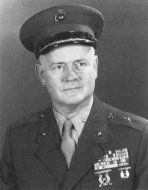
Brigadier General Gordon D. Gayle, USMC (Ret), graduated from the U.S. Naval Academy in June 1939 and was commissioned a Marine second lieutenant. After completing Basic School in Philadelphia in 1940, he was assigned to the 5th Marines, 1st Marine Division with which he served in three Pacific campaigns: Guadalcanal, Cape Gloucester, and Peleliu. For his extraordinary heroism while commanding the 2d Battalion, 5th Marines, on Peleliu, he was awarded the Navy Cross.
He returned to 1st Marine Division in the Korean war to serve first as the executive officer of the 7th Marines, then as G-3 on the division staff. He is a graduate of the Army’s Command and General Staff College. In 1963–65, he chaired the Long Range Study Panel at Quantico, developing concepts for the Corps’ operational, organizational, logistical and R&D needs for the 1985 period. He was promoted to brigadier general in 1964. Retiring in 1968, he joined Georgetown University’s Center for Strategic and International Studies.

THIS PAMPHLET HISTORY, one in a series devoted to U.S. Marines in the World War II era, is published for the education and training of Marines by the History and Museums Division, Headquarters, U.S. Marine Corps, Washington, D.C., as a part of the U.S. Department of Defense observance of the 50th anniversary of victory in that war.
Editorial costs of preparing this pamphlet have been defrayed in part by a grant from the Marine Corps Historical Foundation and a bequest from the estate of Emilie H. Watts, in memory of her late husband, Thomas M. Watts, who served as a Marine and was the recipient of a Purple Heart.
WORLD WAR II COMMEMORATIVE SERIES
DIRECTOR EMERITUS OF MARINE CORPS HISTORY AND MUSEUMS
Brigadier General Edwin H. Simmons, USMC (Ret)
GENERAL EDITOR,
WORLD WAR II COMMEMORATIVE SERIES
Benis M. Frank
CARTOGRAPHIC CONSULTANT
George C. MacGillivray
EDITING AND DESIGN SECTION, HISTORY AND MUSEUMS DIVISION
Robert E. Struder, Senior Editor; W. Stephen Hill, Visual Information
Specialist; Catherine A. Kerns, Composition Services Technician
Marine Corps Historical Center
Building 58, Washington Navy Yard
Washington, D.C. 20374-5040
1996
PCN 190 003137 00


